#(i think; i found multiple sources for this quote)
Text
white people stop telling fans of color what is and isn't racism.
!Impossible Challenge!
!NOT CLICKBAIT!
#fandom racism#you're writing your own little fanfiction#me - directly quoting source material that can be found if you watch the show for more than two seconds#what does race have to do with it? what does my identity have to do with it? - a white person#you said the word literally aggressively#i didn't even notice you were brown - my name is written in arabic script clearly wasn't white european or american there#and all of this on one post#you sound stupid - a white person#where op and i had discussed the topic of racism on it with nuance and come to a conclusion#and suddenly several white people jumped in to belittle me gaslight me and insult me#and by suddenly i mean one was completely unprovoked didn't respond to any of their comments at all until they came after me#and another asked why racism and maul were discussed together since he's an alien and i said he was literally black coded#like what even#why is it such a debatable topic for you#because if it was misogyny being discussed these women wouldn't think twice to do what they did to me today#they weaponised their power as white people and when called out by me they weaponised being neurodivergent and being a woman#and then when a white ally (op) called one out for calling me aggressive multiple times#they didn't argue with her and deleted their comment to escape accountability and an actual apology#whiteness holds power that while we can be in close proximity to it#we will never be able to have the same power#because my statements are taken as a debate piece#whereas white ally statements are taken as solid#the double standard exists#as a micro aggression#and it's why allies need to amplify our voices#reiterate what we say if they have to like using the phrase just as x person said#because they won't listen to us but they will listen to other white people#this isn't star wars exclusive but it has been my experience in that specific fandom today#but it applies to every fandom and everyday life too
10 notes
·
View notes
Text
every—lesser known—canon fact about Levi Ackerman.
infamously over the years, there have been countless false rumors about Levi in particular out of the cast. many of them have become popular, even ubiquitous, and it's annoying!
and also disheartening when you find out it's not true....
and hurtful when you realize it was - sometimes - made up by trolls.
so i'm making this post<3
credit to @levisfavoriteacup for the idea!!
*disclaimer: i'm not perfect, so this may not be Everything™️ but I am confident that it's the majority of information available, and that it's trustworthy. :)

First the most populars. There is no evidence across interviews nor other content over the years that:
Levi is ugly, and is considered ugly in AOT.
Nope. See here: (tumblr link), or:
Isayama finished his first sketch of Levi mostly on a whim, but the moment he drew his face, he had a sense it would work well / he knew he had something good. Something told him: "the yaoi fangirls are going to like this one".
As time passed and his popularity grew, Isayama caught onto this and wanted to portray him more attractively (in multiple ways) to the viewer/reader.
But from the beginning, this was something of the goal. He is short because Isayama had in mind what young women/fangirls in Japan consider attractive: a man with a higher-pitch voice; has a small face; and who is "short but strong".
In the world of AOT, he (in a nutshell) is mostly considered plain or awkward, but combined with his reputation and style, he's very charming. "He cleans up nice." Overall, it is positive :) But more importantly, realistic I think.
He's also something of a celebrity. People who advertise their product as being used by him are more successful; when he's seen in a shop, this by itself is considered "advertising" and more people come in. Quote: ""the tea that the hero bought”".
He's definitely not a 2/10 at any rate😇.
—the 24th episode of Naoki Yoshida's Anime Plan, 2013 / Interview with Frau Magazine, 2013 | Hajime Isayama x Hikaru Suruga (2014) | AU Smartpass - Erwin & Levi Close Up Interview Part 1 | Taking shelter from the rain reprise: Levi and Peaure
Levi’s type would be someone who’s "tough, feminine and sensual".
Levi's type "might" be tall people. But context matters, because in multiple translations "don't you think?" and "might be" are thrown around a lot. Isayama isn't known for his clarity. When asked, he practically said the question right back.
—fan Q&A from a festival in Betsumaga, Aug.2014
What this quote might have come from is a statement by the author of an article Isayama was likely involved in. I can't say this is 100% canon, but in my opinion it's a little less canon than the Smartpass AUs; if those are sub-canon, then this is sub-sub-canon:
Levi's romantic type is someone who walks three steps behind him, and likes cleaning.
In the past, in Japanese culture, for a wife to walk three steps behind her husband implied highly traditional gender roles. What this is much more likely to mean is that Levi's romantic type is someone who will let him protect them, or will run away and survive even if it costs his life. (And they have to like cleaning.)
—the article is from 2013, and no longer exists. but the link was used as recently as 2021 as a source in this post by a reliable translator. I've found this quote also in varying qualities of translation across Japanese and English forums, so to the best of my knowledge, it's reliable.
Levi's cravat is a piece of his mother's dress + he was wearing her dress when Kenny found him.
This is a popular rumor that Isayama has never confirmed (i think it is true, tho.)

December 25th was chosen by his comrades because he doesn't know his actual birthday.
The guidebook only states that it is his birthday. I can't find any more context on this.
—AOT Guidebook; p.256

His character profile:
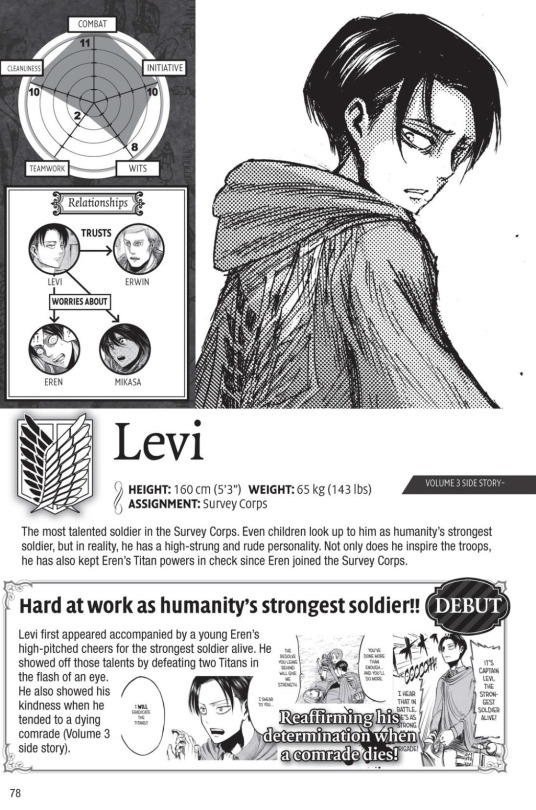
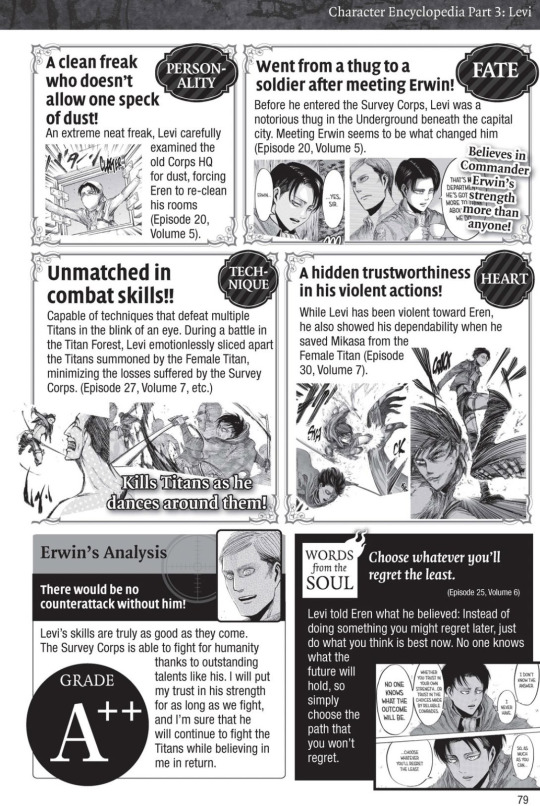
—AOT Guidebook; p.78–79
His name is Hebrew, and means "attached" or to be "joined".
Isayama came up with Levi's name after watching American documentary "Jesus Camp". (It's about a summer camp-type program where evangelical Christian children are taught extreme beliefs. One of the children was named Levi.) Isayama heard it and thought it sounded cool.
—Hajime Isayama x Hikaru Suruga (2014) | 2010 blogpost by Isayama
Levi is in his early 30s (in s3/RtS/volume 19).
–Interview, Universal Studios Japan’s SNK THE REAL exhibition, 2016 | confirmation
If Kuchel was still alive, Levi would want to make sure she had an easy life. This means specifically filial piety, a concept exclusive to the East: he would fulfill his duties as a son for her.
(tldr he's a mama's boy :3)
—Bessatsu Magazine, 2019
Levi would have thin facial hair, but he prefers not to, so he shaves frequently.
—January 2020 issue of Bessatsu Magazine (chapter 124)
He doesn't like coffee milk or coffee jelly. They're out of the question even.🤐
—July 2018 issue of Bessatsu Magazine (chapter 106)
He just gets depressed when he drinks coffee. Maybe he loves tea that much?
He stopped calling Hange names like 'shitty glasses' since they became commander because he "seems" to respect their position that much.
However, a Smartpass story delves deeper into this (and states as I suspected):
[After Hange makes a joke] "Since becoming the commander succeeding Erwin, they’d toned down on their past speech and behaviour that had a touch of tomfoolery; Levi understanding that they were nevertheless trying to maintain the self “that was the case then”, also loses the will to curse at them."
+
"In the past, Hange had a Hange-type dream, and should have been progressing to that purpose. That lately, was it the weight of the office of commander, or was it due to the reality that is “all the world was our enemy”, their manner had changed considerably."
—May 2017 issue of Bessatsu Magazine (chapter 92) | Goodnight. Sweet dreams, dear. Act II: Levi
If he and Kenny had fought one-on-one, Levi would've won.
—December 2016 issue of Bessatsu Magazine (chapter 87)
intermission: all about tea
His favorite "food" is black tea. No actual food.
He doesn't add sugar or milk to his tea because he considers it too expensive—which it is canonically. Despite this, he will share his tea with his comrades (his original squad as far as is seen).
Even though he's Captain, he'd rather drink it straight (the implications of which are he's a hardworking man, like that of a farmer. aka, this makes him seem humble).
If a time of peace ever came, Levi wants to open a black tea shop (he said in a dreamlike way, not so much based in reality).
He also knows a good amount of facts and history about it. He's a tea enthusiast!!
Levi receives pilfered tea in shipments monthly, thanks to Erwin.
—AU Smartpass - Erwin & Levi Close Up Interview Part 2 | Part 1 | Taking shelter from the rain reprise: Levi and Peaure | Bessatsu Magazine, Jan.2014 | September 2016 issue of Bessatsu Magazine (chapter 84) | AU Smartpass My First Time Around: Levi Ackerman | The Case of the Corps Tea Party - File No. 09 Levi's Side (3/3) | sugar and milk in tea from the Japanese perspective
Levi, out of his original squad, found Petra cute/sweet in the general sense of the word "kawaii".
Like Levi's romantic type however, this was sort of a non-answer to the question (of whether Levi thought she was cute).
—2014 interview
After RtS, Levi seems to consider Hange and the 104th his family.
—AU Smartpass My First Time Around: Levi Ackerman
He wears a cravat because Isayama based part of his design off Rorschach from the movie 'Watchmen'.
He looks "delicate" because of his size and weight, but he's so powerful because [in issues before the reveal of the Ackerman bloodline] of "invisible power" at work.
—January 2016 issue of Bessatsu Magazine (chapter 76)
The best way to describe the way he thinks is to compare him to the main character from the movie The Hurt Locker (2008).
His character was born from Hiei from the manga 'Yuyu Hakusho', and Rorschach from the movie 'Watchmen'. The former was the basis for his appearance (especially his eyes), and the latter was the basis for his personality. Firstly though, Isayama had an image of a small man being the strongest.
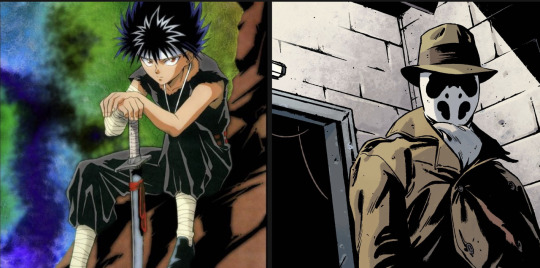
—Hajime Isayama x Hikaru Suruga (2014) / Brutus Magazine (2014)
He is something of a protagonist (especially in s3p1).
— Animedia, June 2018
His favorite tool (in general...?) is microfiber cloths (for dust I guess. Levi has no need for weapons :3)
—July 2015 issue of Bessatsu Magazine
He will usually laugh/smile when he sees convenient cleaning goods (i.e., vacuum cleaners? feather dusters? ((cuz he's a shorty?❤️))
—Bessatsu Magazine, Dec. 2013
He does want to be taller sometimes.
He gets eager to clean up after meals rather than cook at all. He can cook, though.
—Bessatsu Magazine, Aug.2014 | fan Q&A in Oyama, Oita, Mar.2018
Levi mostly couldn't adapt to the changes that came about after the truth was discovered. Only he wears mostly the same uniform, cape, and blades.
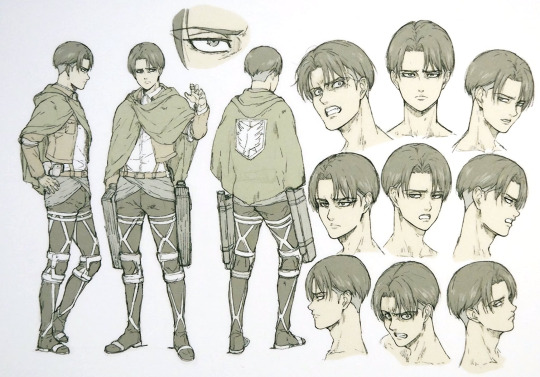
After RtS, Levi personally retrieved Erwin's remains himself, for whom there was a special memorial service.
After Eren (inadvertently) called him a "tiny old man" in season 3, Levi didn't care, but when he thought of it by himself later, he was hurt (unclear exactly why).
Levi's father, most likely one of Kuchel's customers, is an insignificant man who's short. That's where Levi's height comes from. His face comes from his mother.
At the start of season 4, Levi didn't change much compared to the 104th because he's turning into an "old man" who'd rather stick with his flip phone so to speak.
He "doesn't break out into cold sweats". AKA he's always calm under pressure.
He considers prostitution to be an ordinary job because of his childhood.
Levi's vision is very sharp, way above average.
He thought Eren's new look beginning season 4 was unclean/dirty (in more ways than one perhaps).
—fan Q&A in Oyama, Oita, Mar.2018
He has slight bouts of insomnia.
He never snaps/explodes when he's angry. But he does get angry or grumpy a lot, in general.
He doesn't sing. It's more likely he would dance.
If he was a fan of Momoiro Clover Z (jpop girl group), his favorite would be Momoka.
When/if he drinks, he has a high tolerance, but he can get a little drunk :)
One thing he highly hates and fears is mold.
He is the one who ordered Armin to dress as Historia during the uprising.
His blood type is A. Blood types are much like horoscopes in Japanese culture, and Levi's is as such: kichōmen, or well-organized; he likes keeping things neat, but can be stubborn and stressed out easily.
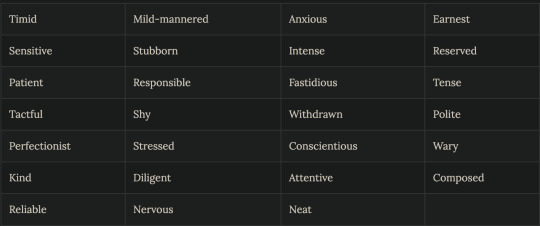
Whether he eats enough or has a good diet? He is "a bit lax".
Maybe he forgets to eat sometimes, or has a low appetite.
When Levi bathes, he goes for a quick shower then soak in hot water, which takes about ten minutes. Like a bird :'))
He on any given night gets about 2-3 hours of sleep.
He thought Eren was the best at cleaning (in season 3 / uprising arc).
Because of his childhood in the Underground, Levi has a preoccupation/obsession with cleaning (specifically to ward off disease).
He also doesn't have any pajamas, mostly keeping day clothes on when he goes to sleep - which is in "his" chair.
Levi cuts his own hair using clippers. (Something like:)

He's aware Oluo imitated him, and found it annoying.
Levi's horoscope (in general) as a Capricorn:
Humanity’s Strongest Soldier - Levi. He possesses warmth in the midst of a dispassionate nature, and he is capable of leadership without verbal expression – both of which are special qualities of a Capricorn. Capricorns tend to hold certain levels of authority, even if they must carry out somewhat unreasonable tactics while in such positions. But when such authority is backed up with actual abilities, a Capricorn can gain Levi’s type of confidence and also be put on a pedestal by those around them.
However, Capricorns won’t be dependent on others, much less trust them easily. They don’t hold high expectations and thus never feel a sense of failure.
Levi’s faults include the inability to express himself clearly. Even though he wants to encourage his companions, he always speaks in a roundabout way, and without Hanji’s translation it’s nearly impossible to understand Levi’s intended meaning.
Even though he is dependable in most situations, when it comes to love/romance, he expresses himself clumsily/awkwardly.
—FRaU Magazine, Aug.2014. | fan Q&A in Oyama, Oita, Mar.2018 | Levi: Close-up Report (Part One) | Translator
*the horoscope wasn't written by Isayama, but was published alongside canon information, and it's also not factually wrong, so I'm including it.
The dark circles under Levi’s eyes are to convey the “self-destruction” he takes on to reach the “standard” of Humanity’s Strongest.
—Interview on the topic of Levi, May 2015
His 'liege'—as Eren is to Mikasa, and Uri is to Kenny—is Erwin.
He is afraid of making deep relationships because of the cruel world he lives in; he can't know when someone he cares for will die or how soon.
That 'gap' left in Levi's heart by Kenny's death was filled by his squad (the 104th).
If Levi hadn't joined the Survey Corps, he would've been a "very irresponsible person". Risky with his life perhaps?
As a kid, Levi used to make himself stronger in order to receive praise from Kenny. When he abandoned him, he wondered what his strength was even for. He was able to find peace with Kenny after his death.
In CH72, the reason Levi kicked the shit out of Eren and Jean is because of his argument with Erwin earlier.

He knows he's a slave to his own strength, aka the idea of being a hero. He realizes it when Kenny asked what he's a slave to in s3/ch69.
—Answers Guidebook, Aug.2016
If he ever changed his appearance, the one thing Levi couldn't be able to give up is his undercut :') He would grow out the top and tie it up :3
—Oyama homecoming event Q&A in 2014 | 2 | 3
Levi knows how to use a gun, but he "places more trust" in knives.
—Bessatsu Magazine, 2019
Levi tolerates saunas. But instead of enjoying himself he seems to see it as a test of endurance. (LOL)
—Bessatsu Magazine, 2020
Levi has newspaper-level handwriting that he practices often. He's very conscious of it and being connected back to the Underground.
—AU Smartpass TEXT: Levi’s Signature
Isayama had considered killing Levi around the time of the thunderspear explosion. (As always) Isayama deliberated with his editors whether or not it'd be meaningful if he died, and they decided it wouldn't be.
—Kawakubo interview, 2021
Specially, Levi holds his swords in a reverse grip "his own way" since he wasn't officially trained.
—Illustrate Note Magazine, 2017

Levi forcefully bathes Hange by knocking them unconscious.
—AU Smartpass - Erwin & Levi Close Up Interview Part 1
Levi is 4 at the time that Kuchel dies.
—What the director informed Kamiya Hiroshi of on set
His character song is called "Dark Side of the Moon", found on YouTube here. Translated lyrics here.
how to draw Levi:
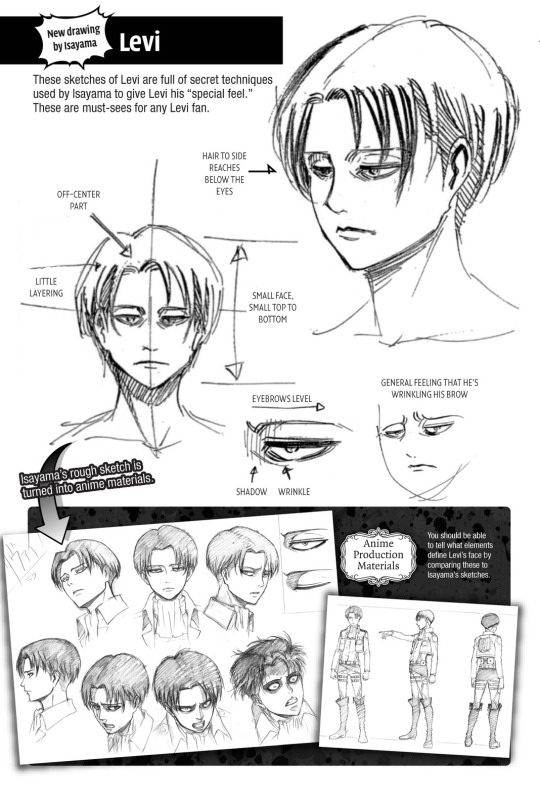
—AOT Guidebook; p.229 | +Illustrate Note Magazine, 2017
#please share... this took days of time and effort#levi aot#snk levi#snk levi ackerman#levi ackerman#levi attack on titan#captain levi#rivaille heichou#levi heichou#captain levi ackerman#levi rivaille#rivaille ackerman#aot manga#snk#levi art#levi shingeki no kyojin#attack on titan#levi.thoughts
251 notes
·
View notes
Text
“Roaming into immortality”: Ten Desires and the history of Taoist immortals

As promised last month, following the freshly established tradition I have another Touhou research post to offer. This time, we’ll be looking into the literary traditions focused on Taoist immortals (or, following the Touhou convention, “hermits”, though this is a less suitable translation) and how they influenced Ten Desires. Due to space constraints and thematic coherence, note that only Seiga, Miko and Yoshika will be covered.
Before you'll begin, I need to stress that one of the sections requires a content warning. While all images are safe for viewing, there's a description of a potentially unpleasant episode involving unwanted advances, and various events leading to that; I highlighted that before the relevant paragraphs too just in case.
“Hermit”, “immortal”, “transcendent”
A post about Ten Desires must start with an introduction of the term sen, the Japanese reading of 仙, Chinese xian. Touhou specifically uses its less common derivative 仙人, sennin, though that's just a synonym. Touhou-related sources basically invariably translate this term as “hermit”. While this option can be found elsewhere too, it is not exactly optimal.
“Immortal” is actually the standard translation for both sen/xian and sennin, as far as I am aware. I did a quick survey of recent publications on Brill’s and De Gruyter’s sites and the results were fairly unambiguous, especially for books and articles published after 2000, with “hermit”, “wizard” and other alternatives being quite uncommon. The trend is not new, with sennin already translated as “immortal” in the 1960s.
When it comes to xian/sen, in a few cases arguments were made that “transcendent” or “ascendent” would be a more suitable option as it better illustrates the position of these beings, though this is a relatively recent trend, for now limited to Sinology. The idea behind it is that immortality is just one of multiple characteristics attributed to the xian, and it is ultimately the transcendence to a higher level of existence that’s the key element. I personally think the argument is sound, but not all translators have embraced it, and for now the choice is really a matter of preference. Since “immortal” is more widespread, and most of the sources in the bibliography use it, that’s what I will employ in the rest of the article, save for direct quotes from Touhou, where "hermit" will be used.
Early history of immortality in Chinese sources
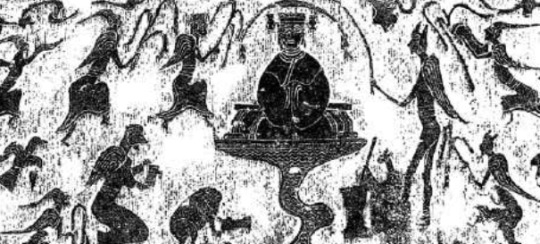
Feathered immortals worshiping Xi Wangmu (from Betwixt and Between: Depictions of Immortals in Eastern Han Dynasty Tomb Reliefs by Leslie Wallace; reproduced here for educational purposes only)
The notion of pursuit of immortality, or at least longevity, is first attested in Chinese sources in the eighth century BCE, when the first bronze inscriptions revealing their authors wished to avoid death altogether appear in the archaeological record. However, the ideas which directly lead to the development of the concept of immortals as discussed here only started to develop in the fourth BCE. Initially they were associated with so-called fangshi, a class of multi-purpose esoteric specialists who often served for example as court diviners.
These ideas developed before the unification of China by Qin Shi Huang, but their importance grew after this event, as many of their proponents were warmly received in the courts of Qin and Han emperors. Some of them, like Wu of Han, even sent expeditions in search of distant lands where immortals purportedly lived, of which Penglai is the most famous.
As a curiosity it’s worth mentioning here that the reception of these pursuits was actually mixed in Chinese historiography. Some of the rationalist Eastern Han authors such as Wang Chong evaluated it critically, basically describing it as a waste of time and resources leading to poor governance.
We know relatively little about the development of beliefs focused on immortality outside of the imperial court in the Han period, though it is evident that they gained considerable prominence, and it’s even possible to speak of “immortality cults” among the general populace. That’s for example seemingly how the worship of Xi Wangmu, arguably one of the most famous Chinese deities, became widespread. Tomb paintings showing blissful immortals also appear in this period.
In art immortals were initially depicted as winged, feathered beings. The origin of this tradition remains unclear, though it has been noted that various similar bird-like beings are also listed in the Classic of Mountains and Seas, attesting to this being a widespread motif in early Chinese tradition. You might be familiar with portraying immortals as wizened sages instead. This convention only developed when the image of the immortal merged with that of the ascetic hermit in the Eastern Jin period - more on that later.
Immortals in Ge Hong’s Baopuzi

A 20th century illustration of Ge Hong (wikimedia commons)
The first formalized instructions for the pursuit of immortality were compiled during the reign of the Eastern Han. Some of them were rooted in the early Taoist tradition, which at the time was also being partially formalized under the Way of the Celestial Masters. Seemingly many Taoist works dealing with these matters were compiled, but most of them are only known from references in Ge Hong’s Baopuzi, one of the most important texts for the study of the history of ideas about immortality.
Ge Hong states that immortality can be obtained through personal virtue and specific practices, including exercise, following strict dietary restrictions and, most importantly, through engaging in alchemy, which he hails as the most effective. All the means to obtaining immortality were unified by one principle: cultivating qi, both by maintaining one’s own and by absorbing it from the right kinds of plants and minerals. Grains were held to be inappropriate food for those pursuing immortality, as it was believed they nourished the so-called “three worms”. The final goal was to be able to use morning dew or light for sustenance. The easiest way to move towards that goal was believed to be consumption of alchemical elixirs, said to possess a more potent, refined form of qi of all their carefully selected ingredients.
Needless to say, many of such magical concoctions were highly poisonous thanks to the inclusion of mercury, cinnabar and other similarly exciting substances. Ten Desires describes the consequences pretty accurately: Miko “turned to the use of various unusual materials, such as cinnabar” which “ruined her body”; as a result she “destroyed her health because of the very Taoism that was meant to grant her immortality”. Such a fate is not historically unparalleled, and there is even a strong case to be made that the notoriously erratic behavior of some of the particularly immortality-obsessed emperors was the result of alchemically induced heavy metal poisoning.
Cinnabar cocktails aside, a further important piece of information from Baopuzi is the reference to three classes of immortals, celestial (天仙), earthbound (地仙) and corpse-liberated (尸解仙). What separated these three groups was the degree to which they perfected their state before formally attaining the rank of immortal. The most refined were basically invited into heaven, with the best of the best taken there on the back of a dragon. Those who despite their efforts lacked something had to put in some additional effort themselves instead.
While the "celestial" and "earthbound" immortals are largely self-explanatory (we'll go back to them later, though), the label of “corpse-liberated” warrants a more detailed explanation. It refers to those who settled for faking own death. This act is called shijie (尸解), and involves substituting the body for an object, which is to be buried as if it was a person. Of course, immortality obtained this way was effectively second rate, though it was not impossible to become a proper celestial immortal later on. As you can probably notice, this is precisely the path to immortality ZUN has chosen for characters in Ten Desires. The term shikaisen used multiple times in the game is in fact simply the Japanese reading of 尸解仙.
Immortals in secular literature

Four Immortals Saluting Longevity by Shang Xi (wikimedia commons)
The importance of the search for immortality grew during the Six Dynasties period. Seemingly in all strata of society a common reaction to frequent political turmoil was to seek solutions in Taoism and still relatively new Buddhism. This in turn left a huge impact on Chinese culture of this era as a whole.
What is of particular relevance for this article is less the straightforward religious dimension of immortality, and more its reflection in literature. Works about immortals were already being written in the Western Han period, with the oldest surviving example being Liexian Zhuan (列仙傳) attributed to Liu Xiang, who lived in the first century BCE. Their importance only grew with time due to the aforementioned process, and they became a well established part of both poetry and prose. For example, a sixth century treatise on literary genres, Xiao Tong’s Selections of Refined Literature (文選; Wenxuan), pretty much the main source to fall back on in the study of pre-Tang literature, recognizes youxian (遊仙), literally “roaming into immortality”, as a distinct type of lyrical poetry. There’s a considerably degree of nuance to this term, since 遊 has the implications of leisurely, playful activity, but these lexical considerations are beyond the scope of this article.
While in some cases the tales of immortals focused on figures primarily known for other reasons, like the Yellow Emperor, Chang'e or Laozi, many document the lives of historical pursuers of immortality instead. Well attested fangshi and Taoist masters appear in such a context, for instance Anqi Sheng or Liu An (according to a legend he ascended to heaven with his entire household, including dogs and other animals).
The literary biographies, or rather hagiographies, of immortals often highlighted their personal eccentricities, tied to their detachment from society. The archetypal eccentric immortals are obviously the members of the group popularly known as the Eight Immortals, though this is a much later development, and the genre conventions formed centuries earlier.
Literature about immortals is interesting from a modern perspective because at least in part it was arguably a secular pursuit. As secular as something could be prior to the rise of the modern notion of secularism, that is (see Mark Teeuwen’s article on Edo period secularism for some arguments against seeing secularism as an entirely modern phenomenon). This is not merely the modern perception, for clarity - the earliest statements to that effect can be found in works of literary criticism from the second century or so. The writers were chiefly scholars, courtiers and officials, not clergy, and naturally their works are not recognized as “canonical” Taoist literature.
Some of these authors took the topic of immortals into rather peculiar directions. According to Xiaofei Kang, during the Six Dynasties period amorous encounters with female immortals (仙女, xiannü) were a “fashionable topic among literati”, while in the subsequent Tang period some authors compared courtesans they sometimes were actually involved with to immortals metaphorically. She notes that they effectively created a genre of works focused on immortals which was no longer really describing the pursuit of immortality, but rather “encounters with enchanting beauties, both real and imagined”.
Needless to say, the literature about immortals remained relevant in later periods, and new stories continued to be written under the reign of subsequent dynasties. Many can be found in Pu Songling’s famous Liaozhai (Strange Tales from a Chinese Studio). This collection was written in the Qing period and remains in wide circulation today as a literary classic.
Pu Songling’s tale of Qing’e: the origin of Seiga
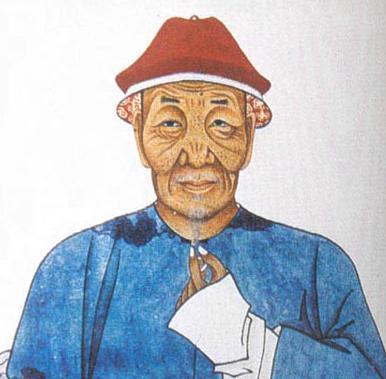
Pu Songling (wikimedia commons)
It is beyond the scope of this article to discuss all of Pu Songling’s tales about immortals, but there is one which necessitates further discussion, namely Qing’e, which is very obviously the basis for Seiga’s character. This makes her somewhat unusual among Touhou characters - while the story she is based on deals with religious themes, and fiction can shape religious views at times (as evidenced by the popularity of Sun Wukong or the image of hell in Divine Comedy), I found no indication Qing’e was ever views as anything but a literary character.
Like the rest of Liaozhai, the Qing’e tale has been translated into English in the 2000s. Songling’s works have an older and more famous translation too, but it’s just a selection, and it has many issues, which you can read about here. You can read parts of the more modern translation on Google Books. Obviously it can also be found easily in other places. I will also summarize the story of Qing’e below for convenience.
This is where the content warning I mentioned applies: the story is not very explicit, but there are is a scene of what I think counts as attempted sexual assault and other generally unsavory moments of that sort, so if that bothers you, skip ahead to the next section.
The beginning of the story introduces a certain Huo Huan (霍桓) from Shanxi, a sheltered young man of unspecified age (he’s older than 13 but “ignorant of adult desire”, which is pretty vague). He lives in the same neighborhood as the eponymous Qing’e (青娥), a teenage daughter of a certain mr. Wu (武), who was apparently a devout Taoist. Qing’e secretly read through her father’s personal collection, developing an admiration for He Xiangu in the process. When mr. Wu left for the mountains to become an immortal, his daughter declared she will never marry. Her decision is presumably meant to mirror one of the versions of the tale of He Xiangnu, who reportedly attained immortality by remaining celibate and consuming mineral powders (granted, you can also find versions where her immortal career started when she was seduced by Lü Dongbin, but that does not match the story here).
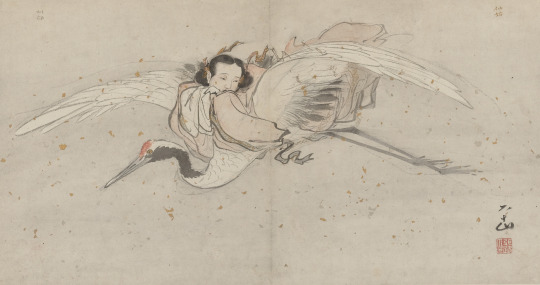
He Xiangnu by Zhang Lu (wikimedia commons)
Huan sees Qing’e outside at some point and, without really talking to her, decides she has to marry her and asks his mother to send someone to arrange that. she doesn’t think it’s a good idea, but eventually caves in. Lo and behold, it doesn’t work and the Wu family is not interested in the proposal. Huan then meets an unrelated Taoist, who offers him a magical tiny spade (one chi long) used to dig up Taoist-preferred herbs (a key component of the immortality keto diet), which can quite literally hack through stone. This convenient deus ex machina gives Huo the idea to hack through the walls of the Wu residence to see Qing’e. Note that the narrator does not approve of this plan, and calls it an “illegal act”. Alas, it comes to pass anyway,
With this newfound power Huan watches Qing’e undress before she goes to bed and then listens to her breathing while she is asleep, as one does with women they saw exactly once before. Eventually he falls asleep himself on her bed. Needless to say, when Qing’e wakes up she is less than thrilled and summons her servants. They assume Huan is a thief, but he tries to explain himself. He’s set free, but the magical tool is confiscated.
Since Huan does not know when to quit, he arranges for a second round of matchmaking afterwards. While apparently Qing’e is cautiously optimistic about it this time, her mother is less than thrilled after learning there are now holes in their residence’s walls. She insults the matchmakers, Huan and Huan’s mother. This in turn makes Huan’s mother angry. She apparently concludes that Huan and Qing’e had sex, and declares that instead of damaging her good name someone should’ve just killed them both on the spot. Qing’e is genuinely sad about this and sends a messenger to smooth things over. However, ultimately nothing really comes out of it.
Some time later, Huan starts a career as a helper of his town’s magistrate, Ou. The latter is surprised to learn he is not married yet, and after hearing about his unsuccessful endeavors intervenes himself. With the help of other local officials he secures the permission of Qing’e’s mother, and the marriage is officially arranged.
A year later, Qing’e arrived at Huan's home. She brings the magical tool with her, and declares that it is no longer needed. However, Huan decides to carry it with him as a good luck charm, pointing out acquiring it was what led to their marriage. Some time later newlyweds have a son, Mengxian, but Qing’e is not interested in raising him and entrusts that entirely to a nurse. After some more time, in the eighth year of their marriage, she announces to Huan that their time together is coming to a close, and there is nothing to be done about this. Shortly after that, she seemingly dies, and Huan and his mother bury her - or so they think, at least.
In the aftermath of this event Huan’s mother falls sick, and inexplicably develops a craving for fish soup, which is hard to obtain in the area the story takes place according to the narrator. Huan, as a staunch believer in filial piety, decides to embark on a journey to procure some. He is initially unsuccessful, but he manages to get some from Wang, an old man he encountered in the mountains. The latter also offers to introduce him to a beautiful woman, but Huan is focused on the quest for fish soup and declines.

Contemporary Chinese fish soup (wikimedia commons)
With the power of fish soup Huan’s mother’s health is restored, and when it becomes clear she’s going to be fine he decides to seek Wang again. He does not find him, but after a long trek in the mountains he instead stumbles upon an unusual cave. Unusual because there’s a house inside it. a house which, as it turns out, is inhabited by Qing’e.
Qing’e is surprised to see Huan. She explains that she faked her death and in reality a bamboo cane was buried in her place. She concludes that if Huan found her, they are presumably fated to be together as immortals. He is then taken to her father, who as established earlier also became an immortal. The initial reception is positive, but Huan makes a scene demanding that Qing’e have sex with him and keeps clutching her arm when she declines. Qinge’s father intervenes, and kicks him out for attempted sacrilege in his hermitage.
Alas, Huan can’t get a clue as already established. He cannot see the house anymore because due to a trick there’s only a cliff in front of him after the doors close, but that’s not really enough to stop him, as he suddenly remembers he has the magical tool with him. He starts digging, and despite insults hurled at him from behind the rocks eventually makes a sizable hole in the cliff. At this point someone, presumably Qing’e’s father, gets fed up, and throws Qing’e out through the hole to get him to leave.
Qing’e, to put it lightly, is not very keen on this turn of events. She nonetheless returns with Huan to his house. Shortly after that they moved elsewhere, to Yidu, where they lived for eighteen years. Qing’e at some point gave birth to a second child, a nameless daughter, who doesn’t really factor into the story. All we hear about her is that she married into a local family.
Eventually Hano’s mother dies. Qing’e picks an auspicious location for her resting place, and tasks Huan and Mengxian with preparing the burial. A month later, she and Huan disappear, leaving the new adult Mengxian alone.
In the final scene of the story, Megxian, who apparently spent the first twenty or so years of his adult life unsuccessfully attempting to pass the imperial examination, meets a certain Zhongxian, and is amazed to learn they bear the same surname. The two quickly realize they’re brothers, and decide to meet with their parents, but they fail to accomplish that since they left Zhongxian’s house in the meanwhile.
The narrator comments that while Huan’s actions were “foolish” and “crazy”, everything he had striven for was granted to him as a reward for his filial piety, and then marvels why nobody stopped him and Qing’e from having more inevitably abandoned children. “That’s really strange,” he remarks.
Seiga’s character between ZUN’s innovations and Taoist tradition

Seiga explaining the powers of a hermit; if only there was a term which makes this explanation even more straightforward... (WaHH chapter 12.1)
As you’ve probably noticed, Seiga’s bio in the Ten Desires omake is remarkably faithful to the adapted source. Even her name is just a Japanese reading of the combination of Qing’e’s given name with the family name of her husband. It does not seem that everything unfolded identically in Touhou, though. There is no indication in the bio, or anywhere else for that matter, that Seiga went back after faking her death, and we instead learn that she decided to travel to Japan, since Taoist “hermits” were uncommon there. Additionally, Seiga presumably kept the confiscated chisel, since her ability, which she eagerly demonstrates in Wild and Horned Hermit, is rather obviously a direct reference to the tale of Qing’e. I will admit that while I do not question Pu Songling’s talent and enjoyed many of his tales, I think ZUN’s version is more satisfying than the original, perhaps because from a modern perspective Qing’e is arguably a more compelling protagonist than her husband, and Touhou effectively treats her as the main character in this story.
Something that I believe is relatively well known is that Seiga’s entire character is a bit of an anachronism: to encounter Miko, she would need to be alive through the end of the Six Dynasties period already. However, since ZUN adapted much of the tale of Qing’e directly, like her forerunner she idolizes He Xiangnu, who according to legends about her was only born in the Tang period, and attained the status of an immortal in the early eighth century, during the reign of emperor Zhongzong - nearly a century after Miko’s semi-historical counterpart passed away. I do not think this mistake is meaningful. Save for the references to He Xiangnu and imperial examinations, the tale of Qing’e is set in a largely timeless world. I would presume it’s just a small mistake on ZUN’s part, and he didn’t check the chronology while summarizing the part of the story he wanted to use in Seiga’s bio. There is no need to ponder if Seiga’s power lets her travel in time, as the wiki (which, as we all know, prides itself in maintaining “neutrality” and enforcing correct exegesis of the source material, especially Hisami’s bio) does.
There is a further aspect of Seiga’s character which might evoke works about immortals, though I am not sure if this was intentional. As we learn from her entry in Symposium of Post-Mysticism, she “cannot become a celestial due to her personality, but that does not seem to bother her”. The term dixian which I already brought up before designated immortals who were not interested in ascension to heaven. According to Ge Hong, there were actually many benefits to such a fate, and while nominally a dixian ranked below a tianxian (in Touhou terms, a celestial), they had much more freedom. He states that the archetypal immortal Peng Zu, who spent over 800 years on earth, did so because the upper echelons of the heavenly hierarchy are occupied by well established deities, and any immortal joining their ranks would be burdened with tiresome tasks and obliged to act as servants, making their life less enjoyable than it would be on earth.

Peng Zu (wikimedia commons)
Poetry describing the earthbound immortals originally developed in the third and fourth centuries. Parallels can be drawn between their protagonists who reject the celestial bureaucracy with a different class of literary characters popular at the same period - non-conformist recluses who did not care about the mundane, earthly administration. The dixian is essentially a merge between the classical supernatural immortal and the archetypal hermit. This sort of immortality was a metaphor for unrestrained freedom first and foremost.
I will stress again that I have doubts about whether ZUN was aware of this when he came up with Seiga, but it certainly does fit her well. Also, more recently, in Who’s Who of Humans and Yokai in Gensokyo he actually says that “she may be the most hermit-ish character here”. I’d hazard that even if he was not aware of this idea before, he probably is now, in some capacity at least. It’s not like Seiga’s status as a “wicked hermit” was ever tied to lack of interest in heaven, as opposed to necromancy, so this does not contradict anything established.
Reception of Chinese tales about immortals in Japan
Obviously, ZUN is not the first person in Japan to adapt literature about immortals.Something that needs to be stressed before delving deeper into the topic is that transfer of beliefs, and especially tales, pertaining to immortals to Japan did not constitute the spread of Taoism as an organized religion. It is instead simply an aspect of the widespread adoption of elements of Chinese culture. While Taoist ideas were an aspect of this phenomenon, we know relatively little about how they were transmitted to Japan, though there was clearly no effort to introduce the religion itself in a formal manner the way Buddhism was. This topic ultimately can’t be explored here in detail due to space constraints. but most likely what occurred was gradual introduction of certain elements in informal contexts: through art, Buddhist borrowings or poorly documented individual ventures.
The earliest recorded example of reception of motifs related to immortals in Japan is likely the tale of Tajimamori from the Nihon Shoki, which involves a quest for items granting immortality. The much better known tale of Urashima Taro, also preserved in this source, is another candidate, and as a matter of fact was recognized as an example of literature about immortals in the Heian period already.
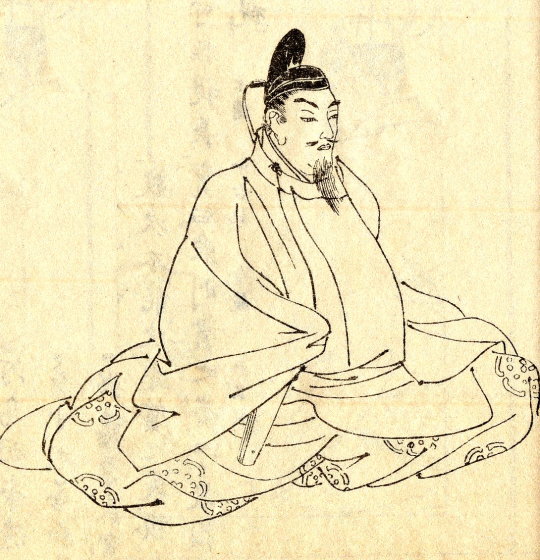
Ōe no Masafusa (wikimedia commons)
However, our main source of the early Japanese perception of immortals are not the early “national chronicles”, but rather Honchō Shinsenden (本朝神仙伝). Its author was Ōe no Masafusa (1041-1111), an official and scholar from the Heian period. His career culminated when he was appointed to the prestigious position of the governor of Kyushu, though he eventually abdicated to dedicate himself to writing. His work is classified as an example of setsuwa. At the same time it is also firmly tied to the already discussed tradition of Chinese secular immortal literature, and can effectively be considered an attempt at creating a Japanese equivalent of collections of biographies of immortals. Obviously it has its own unique peculiarities to offer too.
Masafusa’s work presents an interesting case of fusion of the Taoist-influenced Chinese notion of immortality with Buddhist ideas: the immortals are compared to hijiri (Buddhist “holy men”) and “living Buddhas” (ikibotoke). This is not entirely a novelty, as while Buddhists are absent from Chinese compilations of biographies of immortals, Laozi’s ascent to immortality was nonetheless at times described in similar terms as Buddhist Nirvana, at least in sources from the fifth century. There was also a preexisting Buddhist tradition of legendary long-lived patriarchs awaiting the coming of Maitreya or simply extending their lifespans to save more beings. Therefore, while innovative, this combination of Taoist and Buddhist elements was hardly something unparalleled or contradictory.
The selection of figures described as immortals in Honchō Shinsenden is also a bit different than in its Chinese forerunners. Legendary heroes and historical statesmen do show up, as expected. However, alchemists and members of Taoist clergy are missing, since they were not exactly common in Japan. Buddhist monks effectively replace them as the main social group among immortals, though it does not seem religious devotion is the deciding factor. Ultimately there is no clear pattern, not even that of virtuous life: Masafusa’s immortals as a group are not meant to be moral examples, even though some of them are portrayed as paragons of virtue.
It seems ultimately what Masafusa wanted to do is present stories he personally found interesting or awe-inspiring, and there was no religious aim behind his work. Some of his choices were actually criticized as inappropriate by his contemporaries, in particular the inclusions of Zenchū and Zensan, who according to polemics were not immortals, but merely devout Buddhists taken into a Pure Land (a heavenly realm created by and inhabited by a Buddha) in their current forms, without reincarnation. This argument follows the well established aspect of esoteric Buddhist doctrine, which enabled the possibility of achieving enlightenment in one’s current incarnation.
A total of thirty seven tales formed the original manuscript, though not all of them survive. They range from long, grandiose narratives about figures like Yamato Takeru and En no Gyoja to brief, almost comedic accounts of the tribulations of anonymous figures such as the “stick-beaten immortal” (who learned how to levitate, but only up to the height of one shaku, which meant that he could not even escape children hitting him with sticks) or the “old seller of white chopsticks” (whose title tells you a lot about his economic situation). Only two are ultimately important here, though: those of the semi-historical prince Shotoku, and the firmly historical poet, historian and eccentric Miyako no Yoshika.
Simply put, I believe Honchō Shinsenden is responsible both for the portrayal of Shotoku as a Taoist immortal and for the inclusion of a character (vaguely) based on Miyako no Yoshika in Ten Desires.
Honchō Shinsenden’s Shotoku and Toyosatomimi no Miko

The image of prince Shotoku through the ages
Prince Shotoku (聖徳太子) is one of the highest profile figures to ever be portrayed in Touhou, and as such arguably requires no lengthy introduction. He purportedly lived from February 7, 574 to April 8, 622, and served as a regent on behalf of his aunt, empress Suiko. He is traditionally credited with spreading Buddhism in Japan, ordaining numerous monks, writing commentaries on sutras, vanquishing rivals such as Mononobe no Moriya with the help of the Soga clan, and so on. He might have not existed at all, or perhaps he did, but played nowhere near as major of a role in Japanese history as traditionally assumed. The academic debate started a few decades ago, and remains ongoing. Its outcome isn’t really important here, since regardless of Shotoku’s disputed historicity, he came to be well established both as a religious figure and as a literary character. At various points in time and for various people, Shotoku was, in no particular order, the ideal statesman, a manifestation of Kannon, a peerless military commander, a yaoi protagonist and, most importantly, an immortal.
In Honchō Shinsenden, Shotoku is referred to as “prince Jōgu” (上宮), though we do get the mandatory Shotoku namedrop indirectly when his virtue (聖徳) is highlighted.. He is actually one of the two only of the listed immortals who can be classified at least vaguely as “statesmen”, the other being Yamato Takeru. For unknown reasons, Masafusa got some details wrong: according to him Shotoku’s father was Bidatsu. This view is unparalleled, and there is no real reason to doubt the conventional genealogy, which firmly positions him as a son of Yomei and his half-sister Anahobe no Hashihito. We learn that his birth was foretold by a dream in which his mother saw a golden figure who entrusted her with a child who will spread the dharma. This is in itself a combination of Taoist and Buddhist elements, seemingly an attempt at imitating a legend about the birth of Laozi, which in turn depended on a legend about the birth of the historical Buddha.
Naturally, Shotoku already displayed supernatural abilities as a child. Masafusa reports that whoever touched him was imbued with a “lasting fragrance”. A variant of the well known tale which his Touhou counterpart’s name and ability reference is presented here too, though a key detail differs - Shotoku can listen to eight, rather than ten, people according to Masafusa. This is not unparalleled, and therefore probably isn’t a mistake unlike the unexpected genealogical change mentioned before.
A major event from Shotoku’s life relayed by Honchō Shinsenden is an alleged meeting between him and Illa (Nichira), a Korean monk living in Japan. The historicity of this episode is debatable, as Illa died when Shotoku (if he was real in the first place, of course) was only eleven years old. He identifies the prince as the bodhisattva Kannon, and pays respect to him as such. In response Shotoku emitted a beam of light from between his eyebrows, which reflects both Taoist and Buddhist traditions about manifesting supernatural powers.

Illa's alter ego Atago Gongen (wikimedia commons)
Interestingly, Illa responds by doing the same, thus revealing his own supernatural character. We know from other sources that Illa could be identified as the true identity of Atago Gongen, the tengu-like deity of Mount Atago. Bernard Faure notes parallels can be drawn between his portrayals as a foreign supernatural ally of Shotoku and as the human alter ego of a deity with the traditions pertaining to Hata no Kawakatsu. There is also an “immortal of Mount Atago” in Honchō Shinsenden, but his identity is left unspecified. It's worth noting that in Symposium of Post-Mysticism Byakuren and Marisa at one point discuss the existence of “hermit-like tengu”. Illa truthers… we can make it happen if we believe strong enough… Jokes aside, I’m actually cautiously optimistic that Illa might some day end up being the first Korean character in Touhou, at least implicitly. Given the inclusion of references to Hata no Kawakatsu, odds are decent ZUN knows about him too.
In another anecdote, we are introduced to another member of Shotoku’s supernatural supporting cast, the black steed of Kai. This horse is credited with being able to travel the distance of a thousand ri in a single move. This is seemingly an adaptation of a Taoist motif too, as immortals were believed to favor traveling on supernaturally fast steeds, or in cloud chariots drawn by such animals, or to move instantaneously through other means. The fabulous distance of 1000 (or even 10000) ri is conventional, too.
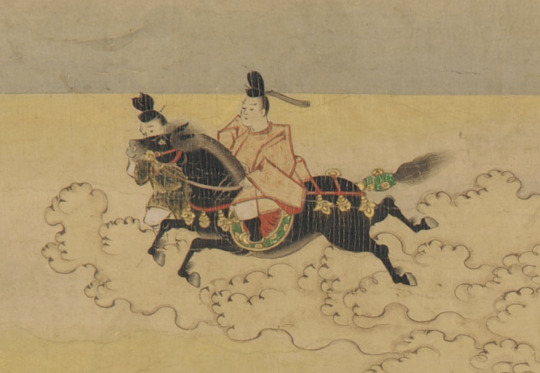
Shotoku traveling through the sky on his supernatural horse (Smithsonian Institution; reproduced here for educational purposes only)
Of course, the black steed (kurokoma) is also the very same horse that served as the basis for Saki. While allusions to this connection is probably the second most common genre of fanart of her, it surprisingly took ZUN four whole years to acknowledge it outside of a track title, specifically through two lines in the vs mode of Unlimited Dream of All Living Ghost. Time will tell if anything will come out of it, I’m personally skeptical seeing as we have yet to see a canon work do anything with the connection between Okina and Hata no Kawakatsu even though it was acknowledged in an interview. I hope I am wrong, though.
Shotoku’s various accomplishments are not described in detail, though Masafusa does bring up his famous seventeen articles constitution and the establishment of Shitenno-ji, and additionally states that teachings linked to the Yuezhi people from Central Asia were associated with it (unique opportunity to justify bringing Central Asian deities like Nana and Weshparkar into Touhou).
The final and most important part of Shotoku’s biography, the circumstances of his death - or rather his acquisition of immortality - is only partially preserved. According to Masafusa, one day he simply informed his wife (presumably Kawashide no Iratsume, as opposed to one of the other three wives) that he cannot exist anymore in a “defiled” world and “transformed” himself. It is actually not explained how he even mastered the techniques allowing that, presumably because we are meant to attribute this miraculous feat to his status as a saintly Buddhist. The authors behind the most recent English translation, Christoph Kleine and Livia Kohn, suggest that in the lost final sentence(s) Masafusa might have combined the Taoist take on immortality with Amida’s pure land, but this is ultimately speculative.
ZUN actually went for something closer to the Chinese model with Miko - she was explicitly taught by Seiga. The notion of immortals mentoring those they deem worthy to pursue the same path is a widespread motif, and even some of the Eight Immortals gained their status this way. This idea is absent altogether from Honchō Shinsenden, perhaps since it was tied to formal transfer of Taoist teachings. While this is an innovation, I would argue it’s still true to Shotoku legends, considering they are already filled with miracle-working visitors from distant lands, from Illa and Hata no Kawakatsu to considerably more famous Bodhidharma.
From eccentric to immortal: the literary afterlife of Miyako no Yoshika

Miyako no Yoshika (wikimedia commons)
As I already said, the second tale from Honchō Shinsenden relevant to Ten Desires is that focused on Miyako no Yoshika. He obviously shares no direct connection with prince Shotoku. Or with Qing’e, for that matter. Unlike prince Shotoku, he left a solid paper trail behind, and there’s no doubt that despite having quite a career as a legendary figure, he was originally a historical person. He lived from 834 to 879, in the Heian period. He was a calligrapher, a poet, an imperial official and for a brief time even an assistant to the envoy to Bohai (Balhae). The inclusion of a character based on him in Ten Desires might seem puzzling at first glance, since none of this seems particularly relevant to the game, and Yoshika’s omake bio doesn’t say much that helps here, beyond calling her a “corpse from ancient Japan”. However, I believe Honchō Shinsenden sheds some light on this mystery.
In Honchō Shinsenden, Miyako no Yoshika belongs to the small category of literati pursuing immortality, a status he only shares with Tachibana no Masamichi. There are a number of other immortals listed who are neither monks nor statesmen, and can be broadly classified as laypeople, though none of them seem to have much to do with those two. In contrast with figures like prince Shotoku, described as pious sages, the fictionalized take on Yoshika is meant to highlight extreme eccentricity instead. This is an element common in accounts of Chinese immortals’ lives too, as I highlighted before. You might also remember this topic from the Zanmu article from last month.
As we learn, Yoshika, who was originally known as Kuwahara (misread by Masafusa as Haraaka, an actually unattested surname) no Kotomichi but changed first his family name (for unknown reasons) and then also his given name because of a poem he liked, decided to become an immortal under rather unusual circumstances. In the very beginning of his career, after spending a night with the concubine of an official from the Bureau of Examination who was meant to examine him the next day, Yoshika decided that his goal in life should be to become an “eccentric immortal”. He passed his official exam without any trouble, with an unparalleled score. Graffiti in the academy he attended proclaimed him the “world’s greatest maniac” (so he comes prepackaged with a Touhou-appropriate title). He attained widespread acclaim for his wit and poetic skill. In his free time, he engages in celebrated literati pastimes such as drinking and sleeping with courtesans (Masafusa does not specify if he wrote about that, like his Tang counterparts did).
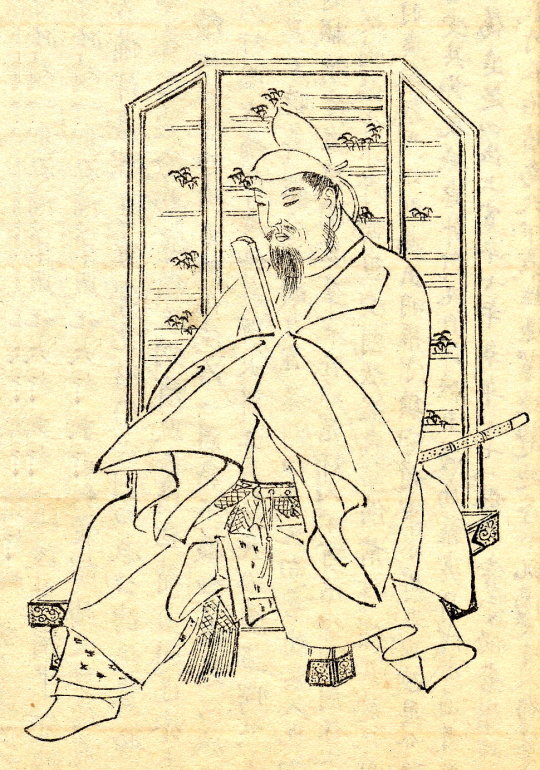
Sugawara no Michizane, Yoshika's apparent nemesis (wikimedia commons)
Alas, Yoshika’s career ultimately did not go entirely according to his whims. The beginning of the end was the day when he acted as the examiner of a new rising star, Sugawa no Michizane. The latter has proven himself to be even more skilled than him, and eventually rose to a higher rank than Yoshika. The latter could not bear this perceived offense against him and one day left his life behind to return to the pursuit of immortality. He aimed at the mountains, hoping to find immortals there to learn their techniques. Masafusa does not provide much detail about his further life, but states that after many journeys he evidently accomplished his goal, as he was purportedly seen alive and well a century after his alleged death.
It’s worth pointing out here that this course of events follows a Taoist motif: becoming disillusioned with one's own career, or with earthly affairs in general, is a common catalyst for search of the Taoist way in literature. A point can actually be made that of all the immortals in the Honchō Shinsenden is the most quintessentially Taoist one (despite not actually being a Taoist), the most direct example of the Chinese model being adapted for a Japanese historical figure, with no addition of the Buddhist components. He even resembles the typical image of a Tang scholar-bureaucrat invested in search for immortality just as much as in amorous adventures. This arguably makes him the perfect basis for a character in a game centered on Taoist immortals in Japan, though truth to be told I feel that in contrast with Seiga and Miko, ZUN’s Yoshika does not live up to her forerunner.
Legends about Miyako no Yoshika in other sources, or the remarkable poetic career of Ibaraki-doji
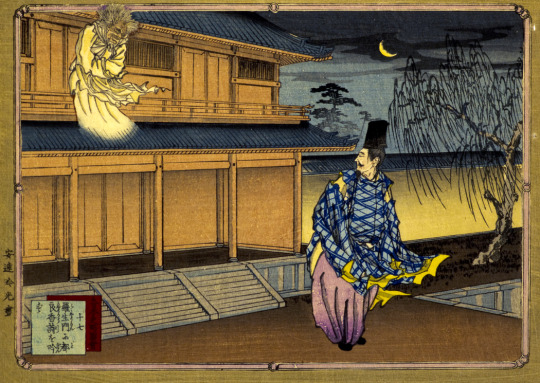
The oni of Rashomon and Miyako no Yoshika, as depicted by Ginko Adachi (Yokohama Art Museum; reproduced here for educational purposes only)
Some of you might wonder where Ibaraki-doji fits into this, considering the pretty direct reference to Yoshika's poetry in Wild and Horned Hermit. Masafusa, as a matter of fact, does allude to one more legend while highlighting Yoshika’s poetic talent, though he doesn’t go into detail. There’s no direct supernatural encounter - a nameless demonic inhabitant of Kyoto’s gate only hears a poem from passersby marveling at it and becomes “deeply moved”, but that’s it. The name Ibaraki-doji doesn’t show up at all, and there’s no mention of the oni finishing the poem, which is a mainstay of later versions.
Another of Masafusa’s works, Gōdansho (江談抄), also doesn’t use the name Ibaraki-dōji, or mention an actual encounter between Yoshika and the oni - he merely hears an unnamed passerby hum the poem and comments on it, calling it touching. However, the Kamakura period collection Jikkinshō already presents the version which gained the most traction in the long run, with the poem being a collaboration between Miyako no Yoshika and an oni. He later recites the full composition to Sugawara no Michizane, who is correctly able to point out only some of it is Yoshika’s own work, while the rest was added by an oni. However, once again, the name Ibaraki-doji is nowhere to be found.
On the other hand, while the story of Ibaraki-doji can be found in Taiheiki and other similar sources, it takes place far away from the capital in these early versions. The location was changed in noh adaptations of the legend to Rashomon, presumably due to its preexisting associations with supernatural creatures. By the time Toriyama Sekien published one if his famous bestiaries, Konjaku Hyakki Shūi, it seems the idea that the oni inhabiting this gate who was encountered by Yoshika and Watanabe no Tsuna’s nemesis Ibaraki-doji, who fought him there, were one and the same was already well established. Note that Sekien’s description of the oni of Rashomon actually doesn’t use the name Ibaraki-doji, though we do know he was aware of it.
It’s worth noting that the oni of Rashomon seemingly had a broader interest in fine arts, since there is also a legend in which he meets the famous biwa player Minamoto no Hiromasa and shows him his own skills with this instrument. However, this is ultimately not directly relevant to Yoshika, so you will have to wait until the next article, which will cover Shuten-doji and Ibaraki-doji in detail, to learn more.

The oni of Rashomon, as depicted by Toriyama Sekien (wikimedia commons)
Bibliography
Bernard Faure, From Bodhidharma to Daruma : The Hidden Life of a Zen Patriarch
Xiaofei Kang, The Cult of the Fox: Power, Gender, and Popular Religion in Late Imperial and Modern China
Zornica Kirkova, Roaming into the Beyond: Representations of Xian Immortality in Early Medieval Chinese Verse
Christoph Kleine & Livia Kohn, Daoist Immortality and Buddhist Holiness: A Study and Translation of the Honchō shinsen-den
Michelle Osterfeld Li, Ambiguous Bodies. Reading the Grotesque in Japanese Setsuwa Tales
Masato Mori, "Konjaku Monogatari-shū": Supernatural Creatures and Order
Masuo Shin'ichirō, Daoism in Japan (published in Brill’s Daoism Handbook)
Leslie Wallace, Betwixt and Between: Depictions of Immortals in Eastern Han Dynasty Tomb Reliefs
287 notes
·
View notes
Text
There was one inevitable downside (/upside for Tumblr Drama fans?) to all of these poll tournaments coming to Tumblr, and that's "fandom polls being run by people with a massive bias/opinion that they can't help from plastering all over the posts".
Like, there's this one New Vegas poll currently running where the OP has a seething hatred for Cass, among others - badmouthing characters in their poll posts, getting into ranting arguments about it. It's inconsequential and funny, and situations like this are a dime a dozen on this site, but seeing this made me want to take a look at this one a lil closer. Because it brushes into something small I've always found interesting about New Vegas: the rumor of homosexuality in the Legion, as well as a wider factor about the writing of companions in general (Under a read-more for length).
OP literally says "If you tell her you're a gay man, she calls you a nazi", so lets take a look at the line they cite for this:

There's multiple points where characters joke about the Legion having similar prominent homosexuality to the actual Romans (which was notable enough that there's straight-up a "Homosexuality in ancient Rome" Wikipedia page). For example:

- Veronica

- Major Knight
What's interesting is that the one character who talks about his direct experience with this subject, Jimmy (a former Legion slave), actually says something that contradicts that last quote:

This opens up the likely possibility that it's NCR propaganda - a homophobic lie to emasculate the enemy. Even if maybe it IS something common in the Legion, it's something frowned upon and is at best a rampant open secret. Either case makes Major Knight's quote provably false.
Regardless, it's a wide non-Legion belief that homosexuality is common and accepted in the Legion. If the source of that rumor IS cooked-up homophobic propaganda, it's interesting that it hasn't worked on the only characters who talk about it. All three of those quotes not only have no ill will toward the idea (Cass immediately states it's not an issue AND notes how common it is behind closed doors), but two of them are mentioned in a context of longing: Veronica's quote is immediately followed by her being angry that only men are allowed to be gay, wishing the same for lesbians. Major Knight's quote is in the context of him having to hide his homosexuality at work -- which sadly makes it clear that the propaganda was likely more effective in general than on the one straight character who mentions it.
I'd say it's funny that OP has a hatred of Cass for being homophobic despite being one of the few characters in-game who makes an explicit statement of not having a problem with homosexuality (I for one would've loved to see Boone - the biggest NCR bootlicker around - make his stance clear on the matter). But admittedly it IS tactless and clumsy to make a backhanded comparison of gayness to the Legion (that statement's obvious expository purpose aside). They also read "there's a lot more of that in the Mojave" to mean "ew, it's not this bad where I come from!", but Major Knight makes it clear that where she comes from is actually MORE supportive. As well as another comment she makes about having slept with women while drunk, which OP construes as likening homosexuality to a drunken mistake.
Like, relax. Yes, "I have no problem with it" isn't the most heartfelt statement of support. But the most Cass' words betray about her is ignorance. I think it's clear she's well-meaning but ignorant, and for the most part intentionally written that way. Most of the companions have intentional personality flaws - Cass is crass, tactless, and stubborn. Arcade is an idealist to a fault (in the game's opinion). Boone is blinded by loyalty to a flawed system despite enacting the worst parts of it. Veronica talks like every line was written by Joss Whedon. The others' flaws are a little more external, but ALL of the companions are intended to be flawed and have pros and cons (while not entirely equal), and all are still intended to be well-meaning people despite this.
It reflects a realism in the nuance of human beings. In general, the writing often tends to rely on this "no black or white, ALWAYS nuance" approach to an almost frustrating degree - like I WISH you could get a better ending for the Followers in a "did everything right" Yes Man ending, even though I know the phrase "did everything right" itself goes against the core philosophy of NV. The poll thing was intended as more of a jumping-off point to talk about some stuff in New Vegas I find interesting rather than a response to that post, but honestly - I know Tumblr has a bit of a problem with seeing nuance, but have a little faith in the writers, will you?

Oh. They... think the game itself pushes the idea that "all fascists are gay"??? How can you be a fan of this game yet have such a low opinion of its writing? Such a lack of critical understanding? This person says "According to my academically trained eye..." and then goes on a series of reaches that critically misunderstand the text in a really unfavorable way, just because they were (understandably) offended by a clumsy offhand statement a character makes and immediately clarifies. And they chose to run a poll despite their open hatred for some of the characters involved (they also seem to hate Boone, for obviously more understandable reasons). Interesting choice.
What's funnier is that OP's open disdain for this character makes it more likely for Cass to win the poll on account of spite votes. Cass would've absolutely been buried by Arcade and Veronica in any other scenario.
Anyway, here's a YouTube comment I found while grabbing these quotes that I found funny:

[Transcripts of screenshotted quotes are available in the alt text]
673 notes
·
View notes
Note
you go on and on about people already hating on the show (which, fair, we haven't seen it yet, although from things being cut to wanting to appeal to got viewers i understand where the sentiment is coming from), but you are doing the same thing on the other end of the spectrum.
why are you so hellbent on defending a show you also haven't seen yet? and bryke leaving the project is not really a sign for good things to come, since they also left shyamalan's production
First of all, Bryke leaving was amazing news for the project, and it was the first time that I found myself feeling actual optimism for the live action since it was announced. And secondly, they were very positive about the movie before the waves of criticism hit and they fucked off to throw Shyamalan under the bus about it and pretend it had nothing to do with them. They were Executive Producers on that shitshow and it's amazing to me that they managed to escape with so little accountability, despite the mess they made of the world of Avatar in all subsequent canonical materials (the comics and LoK in particular).
Thirdly, I'm not actually 'doing the same thing', because what I'm doing is pointing out how ridiculous the over-the-top criticisms thus far have been--what I have not been doing is making up my own idea of what the show will contain and reacting to it as if it has already come out and proven me correct.
In fact, I've said multiple times that I don't know if the show will be good, or if it will handle the story beats and character arcs it chose to alter well--I'm just not willing to completely write it off sight-unseen based on some out of context quotes pulled from an interview I didn't read. (In fact, I did read the interview, and I came out of it thinking that the biggest stumbling block to my personal enjoyment of the show may well be just how closely they attempted to stick to the source material. Albert Kim is a lot more reverent of it than I feel it actually deserves. But I'm still feeling optimistic!)
That said, the biggest reason I'm being so doggedly optimistic about the show is that I really want it to be good--at this point, not just to spite Bryke (though that's part of it), but also because there are so many people of color involved in the show now (not just the cast, but the show runners/writers/directors too!) and I want this to ultimately be a feather in all of their caps that could launch them to full and bright careers in the future. (Especially the kids!)
But my optimism is based on hopes for what could be in the future, not assumptions on what will be based on some very vague interview responses, and that's the difference between me and the haters.
#atla#atla la#if nothing else that cast and crew deserves to have a project under their belts that they can be proud of#and i really hope this is it#asked#Anonymous
31 notes
·
View notes
Text
The basement scenes in Beyond Evil
Some quotes are from the Beyond Evil scriptbook translated by @/yeoyuo on Twitter. (link to the scriptbook in the comment section)
The setting in Beyond Evil is always both significant and relevant: the reed field, Lee Dong Shik’s basement, Jae Yi’s butcher shop, the archives room, the Japanese restaurant, etc. These different places are highly symbolic — some more than others — and are essential to understand everything that is at stakes.
With this post, I want to give you my analysis of Lee Dong Shik’s basement.
The basement scenes are key moments of the drama for they mark crucial shifts, both in HJW and LDS’ relationship and in the plot itself.
The native title of Beyond Evil translates to Monster in Korean (괴물). The very definition of ‘monster’ is quite complex and even its etymology hints at the many roles monsters can play in our society (and in History more generally).
'Monster' probably derives from the Latin, monstrare, meaning 'to demonstrate', and monere, 'to warn'. Monsters, in essence, are demonstrative. They reveal, portend, show and make evident, often uncomfortably so. (source in comments) This last sentence encapsulates perfectly how Lee Dong Shik is seen by others; Han Joo Won acts as a reminder of such perception when he first arrives in Manyang and is convinced that LDS is the killer they’re looking for. Indeed, Lee Dong Shik is presented as someone demonstrative, whose agonising pain and temper earned him the nickname ‘nut job’ and the stares and distrust of most people in Manyang.
Lee Dong Shik is said to be a monster because he was the prime suspect of a murder he did not commit. Because he became a person so visibly drenched in his own pain that it became difficult to look him in the eye. He then depicts himself as a monster — by interfering in Min Jung’s case — to make sure HJW will play his game and take the bait, because he desperately needs HJW to “bite him”. Because he needs his help to catch Jin Mook and to find the missing bodies. Because if everyone keeps being blinded by LDS’ seemingly craziness, then Han Joo Won needs to be the one to see beyond. He needs to see the bigger picture.
The basement scenes play a huge part in making HJW see the bigger picture because so many elements of truth are revealed in LDS’ basement which makes me think… what if LDS’ basement was a means to rewrite Plato’s cave but in a more paradoxical way? Let me explain.
The basement is a place of confrontation and its dimly lit interior makes it resemble a cave, somewhere underground with no real light. HJW and LDS discuss and make hypotheses in this place, so often that LDS even jokingly suggests that HJW should pay rent at this point since he’s always in LDS’ basement.
What makes it a paradoxical rewriting of Plato’s cave is the fact that the truth is, in fact, found in LDS’ basement, on multiple occasions. However, in Plato’s cave, the cave is the place the philosopher needs to escape from to confront the real light, the sun’s light — i.e the truth — to eventually access the world of Ideas.
In Plato’s myth, the cave is a place in which chained prisoners stare at inverted shadows projected by the fire burning inside the cave and they take these shadows for reality. The fire in the cave represents the notion of culture which is to say, constructed beliefs (this is overly simplified but it’s just to give you an understanding). The people in Manyang are like those prisoners in the cave who are convinced that those shadows are what the real world looks like: they are convinced Lee Dong Shik is the cause of Manyang’s tragedy and doom despite the fact that many cases that took place in Manyang were dropped. The Manyang people believe in the evidence that is the guitar pick as fervently as the prisoners believe the shadows are the only reality that exists. Despite it not being enough to indict Lee Dong Shik, it still made him look like the killer for twenty-one years, to them at least.
Just like the philosopher who decided to climb up and face the burning sun to get to the Truth, Lee Dong Shik is the one who sacrificed himself and ruined his life so that the truth could be established.
To come back to what makes this rewriting paradoxical, here are some truths that were discovered in LDS’ basement:
The posters of the missing people + the files of both Yu Yeon’s and Ju Seon’s cases (before LDS put them back into the archives room) → These enable LDS to carry out his own investigation.
Min Jung’s fingers → LDS brings them to his basement before figuring out what to do with them.
Lee Geum Hwa → LDS figures out the name of the victim of HJW’s sting operation during one of his confrontations with him which took place in his basement.
Yu Yeon’s body → LDS finds the body of his sister inside a wall in his basement.
Jung Je’s memories → Again, Jung Je’s memories come back to him during a heated conversation with LDS in his basement.
However, LDS has to go up into the light, he has to leave the basement and his house to make the truth known. It is within hell that the truth emerges, but it is under the sun’s light that the truth needs to be revealed.
Thus it’s interesting to note that the big reveal — i.e the rain scene in ep 15 when HJW makes LDS listen to his audio recording — doesn’t take place in LDS’ basement but in his yard (outside and not underground). This emphasises the idea that, just like the bodies in Manyang, the truth needs to be dug out.
Just like Lee Dong Shik and the philosopher before him, HJW became the one willing to sacrifice himself so that everyone could know who the real killer was: “I’ll be a monster, take Han Ki Hwan with me, and dive into hell when he’s reached the peak.”.
#this sounded better in my head but I'm tired of rewriting it ><#I'm aware I oversimplified Plato's cave but I hope I got my point across#beyond evil#jtbc beyond evil#lee dongsik#han juwon#*enjoy my nonsense#*beyond evil analysis#my post won't show up in the tags because of the links so I'll add them in the comments
67 notes
·
View notes
Text
Because I have just been informed that I’m not the only nerd who’s been staring at the cuneiform in the Council library for the past year like TELL ME WHAT YOU SAY...

The other day, I was reading the twitter of Nick Farmer, the linguist who provided the Dacian for WWDITS. He said that he used Old Persian Cuneiform for the writing (which would predate Nandor by 1500-2000 years) because he felt that cuneiform fit with vampiric vibes, but that the reading of the characters was “adapted to the phonology of reconstructed Dacian”.
To put all that in layman’s terms... Dacian is an extinct language that was used in ancient times in what we now conceptualize as Eastern Europe. While it was a super common language before and around the advent of the Common Era, archaeologists have found very little that’s actually written in the language. What we know of the language is largely reconstructed, which means that we don’t have much by way of full Dacian texts to study, so linguists have used what little we do have in addition to sources in other languages to try and reconstruct as much as they can.
That means that Farmer got a little creative here! Dacian isn’t typically written with cuneiform, but he said that there have been Old Persian Cuneiform texts found in Romania, which would put that form of writing in the same location as the Dacian language. I believe the word he used was “plausible”. lmao
(Romania is also where we find Transylvania, of course. *Jackie Daytona voice* And that just sounds cool.)
All that is a long way of saying that he used an ancient form of writing to write out the reconstructed sounds from another ancient language in order to create a vampiric tongue. Farmer also used Reconstructed Dacian when writing the conversation between the Baron and the Sire, so that would be the same language that we see in the Vampiric Council.
Anyway, if you’re interested, here’s the phonetic chart Farmer provided!
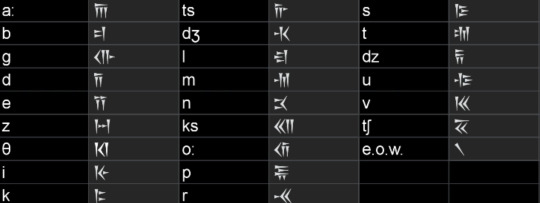
You can see that script used multiple places in s3, such as in the library and on the Vampiric Council website, but on his twitter, Farmer just gave the translation for the library.
𐎨𐎶𐏐𐎫𐎺𐏐𐎳𐎡𐎾𐎰𐎡𐎹𐏐𐎫𐎡𐎧
Tsam tu velthey tieks
As thou wilt, do.
This is, of course, a reference to Aleister Crowley’s most famous quote: "Do what thou wilt shall be the whole of the Law", which is from The Book of the Law. It’s an occult thing.
That phrase is also highlighted here:
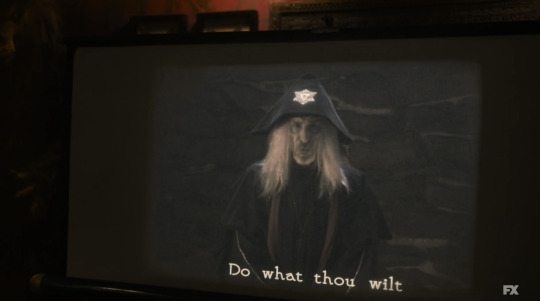

So thanks for the workplace safety tips, Aleister!
And one more fun thing from his twitter, apparently these hats were made for the WWDITS art department, which I just think is cool:

#wwdits#what we do in the shadows#I just learned Middle Egyptian in school I don't know much of anything about Dacian#but I kind of get the impression that no one does lmao
457 notes
·
View notes
Note
Hello, I found this old quote from jimin and I’ve seen it translated elsewhere but I was hoping to get your take on it? It’s from this article
https://n.news.naver.com/mnews/article/415/0000001635?sid=004
지민_ 중학교 3학년 때부터 춤을 춰왔고 부산예고에 수석 입학 할 만큼 소문난 춤꾼이지만 동시에 매력적인 보컬로 방탄소년단만의 색깔을 만드는 데 큰 역할을 했다. 또 ‘짐드백’(지민+샌드백)이란 별명이 생길 정도로 팀 내 서열 꼴찌가 됐는데 어쩌다 이렇게 됐나.
▲ 춤뿐 아니라 보컬에 대한 고민도 많은 편이다. 보컬적인 면에서 아직 너무 부족하다고 생각하기 때문에 스스로 만족할 수 있을 만큼 노력해서 더 좋은 노래를 들려드리고 싶다. 서열 꼴찌인 건 인정한다. 막내 정국이한테 던져지고 나서 이렇게 된 것 같다. ‘정국 맘’이라는 별명이 있는데 이제 ‘정국 장난감’이 된 것 같다.(웃음) 반항할 수 없기도 하지만 그런 장난이 싫지 않기 때문에 어쩔 수 없다.
Hi, thanks a lot for your message.
Since it's quite a bit of text I will give a translation without much of explaining around it for the parts where it just mentions Jimin's history etc and focus more on the parts which I assume were the reason you sent me the message for.
Here I will also try to make it more fun for me (and for those who are maybe interested in going more in depth too) by showing multiple ways of translating certain words or phrases, ranging from 1st option marked as ¹ - 'closest to source' translation (which I typically provide to show what was said in original word as opposed to just transforming it to be more seemless and easier to understand for an English speaker) /2nd option marked as ²- close synonym (kind of middle of the two, optional) / 3rd option marked as ³- 'looser, more flexible' translation (might not be mirroring the source text 100% but brings the essence of the word, phrase closer to the English language and its context). This is just to show translations can vary depending on stylistic choice and preference. Naturally, this doesn't always apply though and there's many further nuances that can be discussed etc.
Note: if you wish to skip the (admittedly long) explanation and my weird number exercise, scroll to the bottom for clean translation.
지민_ 중학교 3학년 때부터 춤을 춰왔고 부산예고에 수석 입학 할 만큼 소문난 춤꾼이지만 동시에 매력적인 보컬로 방탄소년단만의 색깔을 만드는 데 큰 역할을 했다.
또 ‘짐드백’(지민+샌드백)이란 별명이 생길 정도로 팀 내 서열 꼴찌가 됐는데 어쩌다 이렇게 됐나.
"Jimin- You've been dancing since the third grade of middle school and were such a notorious dancer to the point that you got accepted to Busan Arts High School as the top student (*수석 입학), but at the same time, you also played a big role in creating BTS' own specific colors with your ¹attractive / ²appealing vocals.
Though on top of that, you came in ¹last position in the team ranking / ³were last in the team pecking order to such an extent that you ³earned yourself a nickname ¹'jim-deubaek' / ²'jim-dbag' / ³'jim-punchbag' (Jimin + ¹sandbag / ³punching bag), ¹how did it happen / ³how come / ³how did this come about?"
(*note: here of course the tone is playful and the meaning obviously isn't referring to any harmful violence, the question is posed in a way that it implies Jimin is both the top (skills, influence wise) and then finds himself at the bottom when it comes to certain power hierarchy in the group, like when they joke around together (even physically), to the point that not even the youngest regards him as a 'hyung' and rather plays around with him, which Jimin then refers to in the response accordingly)
춤뿐 아니라 보컬에 대한 고민도 많은 편이다. 보컬적인 면에서 아직 너무 부족하다고 생각하기 때문에 스스로 만족할 수 있을 만큼 노력해서 더 좋은 노래를 들려드리고 싶다.
서열 꼴찌인 건 인정한다. 막내 정국이한테 던져지고 나서 이렇게 된 것 같다. ‘정국 맘’이라는 별명이 있는데 이제 ‘정국 장난감’이 된 것 같다.(웃음) 반항할 수 없기도 하지만 그런 장난이 싫지 않기 때문에 어쩔 수 없다.
"Not only dancing, I tend to worry a lot about my vocals too. I think I am still lacking in the vocal aspect, therefore I want to try hard enough to be satisfied with myself and give you better songs.
I admit to being last in ³the pecking order. I think ¹it became/ ³I ended up like this after ¹being ¹thrown / ³tossed around by ¹the maknae Jungkook. I have the nickname ¹'Jungkook's mum' (*the word mum spelled in Korean) but now / from now on I think I am becoming ¹'Jungkook's toy' / ³'Jungkook's plaything'. (Laughter) I cannot ¹defy it / ²resist, but since I don't hate these kind of ¹antics/ ¹play / ²jokes / ²mischief, ¹there's nothing to do / ³I can't help it."
Concluding note: by giving multiple options I tried to show that there are always various ways to go about translations. Here I would say to avoid misunderstanding, it's better to try to convey the meaning of what was said with a bit more flexible translation.
~~~~~~~~~~~~~~~~~~~~~~~~~~~~~~~~~~~~~~~~~
TLDR, clean translation:
Reporter: "(Jimin) You've been dancing since the third grade of middle school and were such a notorious dancer to the point that you got accepted to Busan Arts High School as the top student, but at the same time, you also played a big role in creating BTS' own specific colors with your attractive vocals. Though on top of that, you were last in the team pecking order to such an extent that you earned yourself a nickname 'jim-punchbag' (Jimin +punching bag), how did this come about?"
JM: "Not only dancing, I tend to worry a lot about my vocals too. I think I am still lacking in the vocal aspect, therefore I want to try hard enough to be satisfied with myself and give you better songs. I admit to being last in the pecking order. I think I ended up like this after being tossed around by the maknae Jungkook. I have the nickname 'Jungkook's mum' but now I think I am becoming 'Jungkook's plaything'. (Laughter) I cannot defy it, but since I don't hate these kind of antics, there's nothing to do about it."
(exerpt from 그 여름, 우리가 사랑한 방탄소년단, published 27.07.2016 by atstar1)
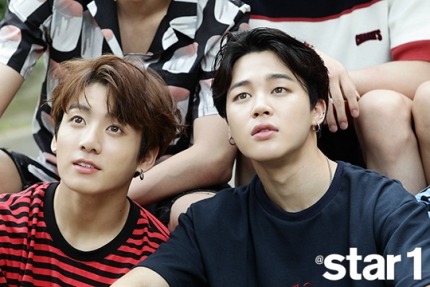
#ask#translations#jikook#민꾸기#the language nerd in me just jumped out here#sorry for the confusing numbering system
150 notes
·
View notes
Text
The pay gap/female choices debate
I was watching this Youtube video the other day, and it pissed me off, but the main point of it was that there were these two men discussing how the pay gap isn't real because it all comes down to women's choices, citing really crappy examples as evidence. They clearly thought they were "owning the libs" too. They did this with 0 contextual analysis on why women make the decisions they do.
The first example they used was the Uber driver 7% pay gap, and how it's completely explained by three factors: (a) that women tend to be less experienced, (b) that men tend to drive faster, and (c) men drive in more lucrative locations. (This paper is Cook et al 20 by the way if you want to fact check me).
And yes, when you put it that way and remove all context for women's decisions, it certainly looks like that sort of moment. But think critically for like two seconds here:
Those more lucrative locations? The paper directly states that it's due to men's willingness to "drive in areas with higher crime and more drinking establishments". Of course men are more willing to do this! Your average woman is significantly more scared of being sexually assaulted, murdered, etc than your average man. She's going to avoid high crime areas because she's already in a vulnerable position (letting strangers into her car).
The fact that women have less experience? The attrition rate for female Uber drivers is substantially higher- 76.5% of women leave after six months, as opposed to 65% of male Uber drivers. I did found an article explaining why women self-select out of being in Uber or Lyft in the first place from Forbes. Quote, "...the job still involves driving alone and picking up strangers, often at night- situations that many women feel are dangerous. In interviews with eight female on-demand drivers, FORBES found that they usually feel safe but sometimes have doubts after troubling experiences and holes in safety policies." The article goes on to describe the experience of a female Uber driver in Atlanta, whose male customer tried to assault her. The company didn't handle the incident appropriately, and she never drove for Uber again. I'm willing to bet that this is the case for other female drivers too. The other women they interviewed (even those who are presumably still driving) described multiple similar experiences.
So, if you were a female Uber driver, you would probably leave around the six-month mark too. And as a result of this high attrition rate, the average female Uber driver will have less experience as compared to men.
And you know what? These other "gotcha" responses about the pay gap can probably be explained by outside factors too. Even in totally automated systems like Uber, where it does come down to female choices, those choices aren't being made in a freaking vacuum. It isn't just "haha pink lady brain can't drive as well", it's women don't feel safe and therefore make less money.
There's other scenarios where this is true as well. Women aren't climbing the corporate ladder as quickly as men? What else is going on? The Harvard Business Review found that more than half of men expect their careers to take precedence in a marriage- so if his is being prioritized always, what's happening to hers? When children get sick, women are ten times more likely to stay home from work to care for them (Kaiser Family Foundation). What does she miss in that lost time? When female scientists write papers, they are less likely than men to describe their accomplishments as *outstanding* or *unprecedented*, with the end result that their papers are cited less often. But it's because when women are socialized to be caretakers and to perform without complaint, this is the end result (Professional Development at Harvard). Worse, women who don't do this, and ask for raises/bonuses/etc, are more likely to be penalized than men (same source).
Yes, women sometimes make "decisions" which negatively impact their careers, but take it altogether. What makes men expect precedence of their wives? Misogyny. What makes men expect that their wives, regardless of their careers, will always nurse their sick kid? Misogyny. What makes women and their employers view female accomplishments as less valuable? You know the answer.
PS: two last things. The first is that I'm not trying to reduce the value of traditional "women's work". It isn't bad that women are taking care of their sick children, it's bad that men aren't doing it in equal numbers.
Secondly, if you're curious, there's this amazing professor named Claudia Goldin who I stumbled across while googling for this. She basically believes that the issue isn't direct discrimination from employers, but that the labor market encourages women to work differently. (And she's like 1000% more nuanced and career-specific than anything I just wrote). I put a link to an article about her below:
#feminism#Uber#pay gap#decisions aren't made in a vacuum lol#I had fun writing this#so it's worth it even if nobody reads#Feminist#womens rights
62 notes
·
View notes
Text
Drakenier: Violence as expression and affirmation - Pt.1
It has become a rather well-known piece of trivia (or at least, well-known within the niche internet circles I flow through) that 2010's Nier Replicant / Gestalt had its overall message thoroughly inspired by well, 9/11 - the discourse that produced it, that came of it, and became it. Although it may not be a direct quote, "to kill someone, you don't have to be out of your mind, you just need to believe you are correct" is a sentiment clearly echoed throughout the game; as the many layers of its central and side conflicts drop alongside the curtains to its second, third (and maybe kind of fourth) playthrough, so does what had, for quite a ways into the game, seemed like a story mostly about finding, nurturing and protecting a community - people to call home.
However, the statement above seems to somewhat conceal-so-as-to-merely-hint-at what I'd argue is a much more complex argument the games lay forth, when looked at as one series. I, myself, have found it difficult in the past to distill both Replicant and the wider series as a whole into one coherent message or thematic frame; partly (and beautifully), because there mustn't be one - this singular reading which eclipses the broad range of experiences that people have come to share with the series - such an idea is preposterously reductive. Still, I think that this mish-mash of "the game is about philosophy and tragedy and nihilism and existentialism and society and humanity and life" and whatnot misses a bit of where the different themes intersect, producing further instances of meaning from the text. I hope to discuss the evolution (were I to sound even more pretentious, I might have used the word genealogy, but I would never stoop to that) of a few central concepts surrounding drakenier's "philosophy of violence" and where they seem to have informed or have been informed by other aspects of the works.
Strap in, because just from writing the introduction I can already tell this is gonna have to come in multiple parts. Hopefully my writing can steer away from boring you to tears throughout all of it.
Spoilers for the whole series!
Part 1: Replicant, and the subjective experience gained from that funky 9/11 fun fact
"Blood is sound, sound is words, and words are power"
This quote, almost a chant from Weiss as the player starts to grasp the gameplay loop of attacking enemies to allow for magical attacks, ties in the game's teaching of that system with what I consider to be the most powerful writing from Replicant (I'm going to refer to it as Replicant for the sake of convenience, obviously Gestalt is included in that). And it is deeply tied to what Taro himself has credited as a major source of inspiration for Replicant in relation to his previous game, Drakengard.
In some ways, Nier Replicant isn't introducing a new, foreign idea over the original Drakengard, so much as bringing out new elements from within its predecessors' critiques of the gaming landscape. Though that only really becomes clear by taking future foresights the series would reach into account; this is the point at which it becomes prudent to ask ourselves one question - how might the game's design regulate the player's interaction with the game world? (A question that, if you're at all even familiar with Drakengard, you probably already know the answer to)
From this, we can extrapolate a lot of meaning from how the original Drakengard was conceived: a game about violence, from the perspective of people who were so immersed in their own awfulness and the general precarity of their world that they cannot enact anything but that same violence. And it is that violence which comes to define them.
I'd also like to do the pedantic thing and bring up the fact that violence can be thought of as more than just physical harm, but also in terms of violation. In that sense, when I claim that Drakengard's characters are defined by violence, I mean it in that their reduction of other people to objects serves as an exertion of themselves - the Dynasty Warriors inspired combat of cleansing battlefields as the only win state reflects back at Caim as his only method of building an identity of his own, one based on strength demonstrated from conquering his enemies. You might find that these 'enemies' are violated the moment they're placed into the game as props that sustain its overall narrative.
In fact, this 'loss of personhood as self-affirmation' theme reverberates into another key factor of the game's story: pacts. They explicitly deprive humans of something of themselves - their ability to communicate, to see, to age, to have hair (sure????) -, and reduces both parties into one shared essence, yet it is what permits its characters to have strength through which they find themselves as able to inflict that dehumanization onto others. Dehumanization becomes their characterization, both from the audience's perspective as well as in-world.
Following that, Nier Replicant does not dispute that destruction of the other simultaneously inflicts upon the self both corruption and affirmation. If anything, it only takes measures to strengthen that sentiment, in light of how the added theme of perspective brings forth a need to now more closely study the subjective experience of perpetrating violence. Thus:
"Blood is sound, sound is words, and words are power"
The gameplay system I've anchored this analysis to comes into play; attacking your enemies gives you the literal strength to continue your offense, by design - ridding them of their life force, their blood, perpetuates the narrative, the words being built, the sealed verses of a prophecy you've set for yourself: that of being a hero to your sister/daughter, friends and general community. This even extends to the lyrics of Ashes of Dreams:
"Are we the plaything of fiends or merely the dreams that we're telling ourselves?"
Though we shouldn't forget that Weiss' comment takes the form of X=Y=Z=W, and it seems I've neglected the 'sound' part of the sentence. As I was writing this, my brain immediately made the association between that and Drakengard 3's focus on the power of Song, which, in fairness, definitely was made with the rest of the series in mind - but, in this instance, that sounds like a bit of a lucky coincidence. Still, what the concept of sound brings to the statement doesn't seem too far off from what meaning could be made at a bit more of a general, rudimentary level, that being: our lifeforce (blood) translates into our ability to be heard (sound), thus effectively giving us narratives about the world around us (words), which gives our actions direction, purpose (power).
From that, we can take a closer look into a lot of different aspects of the game. After all, the reason I proclaimed this piece of writing to be so powerful isn't really because I could - and did - stretch its interpretation to its fullest, but also from the way it manifests itself around the struggles of various characters, while being tied to the game's overall systems and world. Emil receding into his identity as a weapon in order to redirect what he sees as his curse onto those who seek to harm his friends - leading to his sacrifice; Weiss, who also goes on to sacrifice himself, does so in the name of putting an end to this now 5-year mission, grown into his own center of existence; Louise, perhaps reacting to the world around her, saw humanity as something to claim from others, and faced erasure upon perceiving herself as incapable of acquiring it. For better or for worse, the moral codes characters create from their own intentions of living become rigid scripts to follow as self-fulfilling prophecies of their own identities.
We can see that, ultimately, characters across both games tend to follow journeys with a general structure of: bleak circumstances > feeling of powerlessness > violence as a misguided means of reclaiming the power to define oneself > entrenchment in violence becomes overbearing, coming to annihilate the very self which sought to instigate it. From the first Drakengard to the first Nier, this hasn't changed a bit. What changed is a distinct awareness in how the self, or what we might call "us" stands in conflict with the generalized other, "them", and where it uses morality as a catalyst for smoothing out the uncomfortable edges of that conflict.
In fact, the annihilation of the self as, paradoxically, an act of self-affirmation is the very core of ending D for Replicant. And this is, partly, where the inciting 9/11 quote comes into play - given our newfound empathetic understanding of where violence comes from, how do we process it? How do we make sense of it? From the way the world is established, the very act of surviving, for both replicants and gestalts, is somewhat tainted as immoral, and predicated on the erasure of an 'other'. It leaves room for later material to find itself more at ease with this question (and those circle back nicely to ending E from the new version, as well). For now, most of what the game feels comfortable in concluding comes from Kainé, who stands in contrast with most characters by fully rejecting the notion of being a moral agent throughout the entire story, yet the game still offers us the chance to save her - it, mirroring the protagonist, relentlessly believes in her. Not even that "she can be better", whatever better might mean, just that "she can be".
And obviously, finally, we can extrapolate plenty of social commentary from this. Playing off of the thematic material introduced in Automata, we could argue that Replicant's plot is, in retrospect, about slowly building up to the depiction of a certain "Death of God" - which, in nietzschean terms, is not merely society straying from religiosity, but represents an irreparable shattering in the very idea of a centralizing narrative that everyone could subscribe to and fit within. So ends humanity, not just as a species, but as a concept; no longer are people able to identify themselves as containing some unified essence of 'humanity', recognizing the other as a complete self in its own right, as they retreat into the violence that was inflicted against them, which they inflict back at the world - to have your totality reduced to a role in a play that the winner gets to write. And in that sense, I'd argue it captures specific facets of a post-9/11 climate pretty well.
Anyway, gonna make a separate post that's just about Drakengard 3, and then one that's just about Automata, but at a later time!
also, this thesis becomes more relevant when the time comes to analyze automata, but it was still helpful in having me think through the previous games, so I'll drop it here as a reference for now, and will mention it more loudly once we come to specific sections later (not about to be the next target for hbomberguy lmao): http://dspace.library.uvic.ca/handle/1828/14525
Cool that there are people writing about it!! Thank you Xinlyu Tan, the goat!!! Would love to go through more material, but I'm writing this for fun on the side... hope anyone reading this has enough fun with it to go looking for more on their own, go extend the discussion further, blah blah blah. Also hope that I make any sort of vaguely coherent point. And, lastly, I hope you enjoy yourself!
#drag on dragoon#drakengard#drakengard 3#drakenier#nier series#nier#nier automata#nier replicant#nier gestalt#drakenier analysis
31 notes
·
View notes
Text
Lewisohn vs. Cynthia Lennon, Pt. 1 of 3
Seems like we're getting some momentum, eh? Let's keep it going! To that end, here is the first of three posts comparing Tune In against Cynthia Lennon's memoirs. Cyn wrote two memoirs: A Twist of Lennon (1978, henceforth Twist) and John (2005). Lewisohn cites Twist 21 times and John five times, twice in conjunction with Twist. Of these citations, I found issues with sixteen of them. I'm deferring judgment on footnote 9-33 at this time, as it cites three other sources that I haven't gone through yet.
Cyn's memoirs were used both for quotes and for factual information in Tune In. In general, the quotes were less mangled than the ones taken from the 1980 Playboy interview, but I also stumbled upon some other issues, namely plagiarism and mischaracterization of certain events. Some of that will pop up here, but I intend to make standalone posts to explore those issues further.
For previous Lewisohn fact-checking, check out @mythserene's work and my Lewi-sins tag. Onwards!
Twist p.25-6 vs. Tune In 11-22


This passage describes the emotional timbre of John and Cyn’s relationship starting from their art school days. Tune In gives a mostly faithful account – I’ve underlined/highlighted some details that are consistent in both books. There was one line that stuck out to me in Tune In, though: “she knew he’d dismiss her in a second if she didn’t stand up to him.”
There’s no account of Cyn standing up to John in Twist. She withstands his behavior, but there’s no evidence of her pushing back, particularly in the early days. She describes herself as “a quaking, nervous wreck on many an occasion—so much so that the thought of going into college the following day would fill me with fear and dread.” I can’t think of any passages in Twist where we see Cyn standing up to John, and John (2005) is similar. In the latter, Cyn does give a couple of anecdotes in which she goes against John’s will (e.g. having Julian baptized), but this is usually done in an “ask forgiveness, not permission” way, rather than directly confronting him.
In fact, this isn’t the first time Lewisohn mentions Cynthia standing up to John. Just a few paragraphs before the above example, he writes this:

Cyn standing up to John is crucial enough that Lewisohn mentions it twice in short order, but that dynamic isn’t present in either of Cynthia’s accounts. Of course, there’s always the possibility of bias—perhaps Cyn portrayed herself as meeker than she was in practice—but if that’s the case, Lewisohn needs to provide a source. He mentions conflicting accounts multiple times throughout Tune In, but there’s no word of that here.
This isn’t the only time Lewisohn writes something contradicted by his cited source, and in some of those cases, I’ve found information supporting Lewisohn’s account in another, uncited source—we’ll get an example of that in the Twist citations. But I don’t think that’s what’s going on here—I think Lewisohn is subtly but purposefully warping the dynamics of John and Cyn’s relationship to make John come off better. He doesn’t go so far as to erase or excuse John’s abuse, but he implies there was more give-and-take in the relationship than was really there.
Twist p.18 vs. Tune In 10-34


There are no factual errors or misquotes here; Lewisohn is instead too faithful to the source material. Cyn describes her first dance with John as “slow and smoochy”; Lewisohn describes it as “slow, smoochy.” Yeah, he changed the “and” into a comma, but this is still plagiarism. “Slow” is a classic dance descriptor, but “smoochy”? Lewisohn is lifting original, distinct verbiage with little change. If this was a one-off thing, I might give him a pass, but he frequently leans heavily on distinctive phrases from his sources. There will be a post.
Twist p.30 vs. Tune In 13-10


Omission without ellipsis.
Twist p.42-43 vs. Tune In 13-53


A one-word quote from Cyn, but Cyn did not say that one word. Without the quotes this would be fine.
Twist p.37 vs. Tune In 13-64


The quote itself (in green) is consistent here, but check out the surrounding sections in pink. Cyn says that the boys’ magic was “so indefinable as to be almost non-existent at times” until they started playing. Lewisohn uses it as a blanket description of the band while playing. Not the most consequential change, I know, but Lewisohn is nevertheless using a quote in a way that directly contradicts the source.
Twist p.42 vs. Tune In 15-32
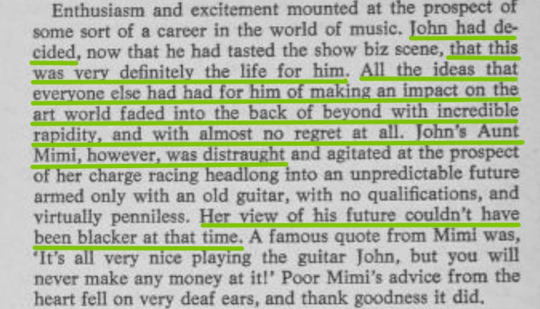

A few dropped words and one large, unmarked omission in the middle of the quote, but the meaning is retained.
Source: Lennon C. 1978. A Twist of Lennon. New York (NY): Avon Books. 190p.
25 notes
·
View notes
Note
I don’t even know how to respond more articulately to this person. You don’t have to answer my ask if you don’t have the spoons btw. So this person posted a TikTok in response to my previous comment to not invalidate people’s experiences on a pro endo video that that person put an anti comment in. Here’s the link:
https://www.tiktok.com/t/ZT8GFtegk/
Here’s my reply but idk what to say really. I probably sound stupid. Plus I think someone mentioned you in the comments section there too.

I think this is a fine answer. Although I might have added that there are other sources that do confirm endogenic plurality. And even the DSM references it in the form of possession states.
Although if you want, I guess I could go into the video a bit more in-depth.
Actually, yeah, it sounds kind of fun! 😁
Let's get into it then!
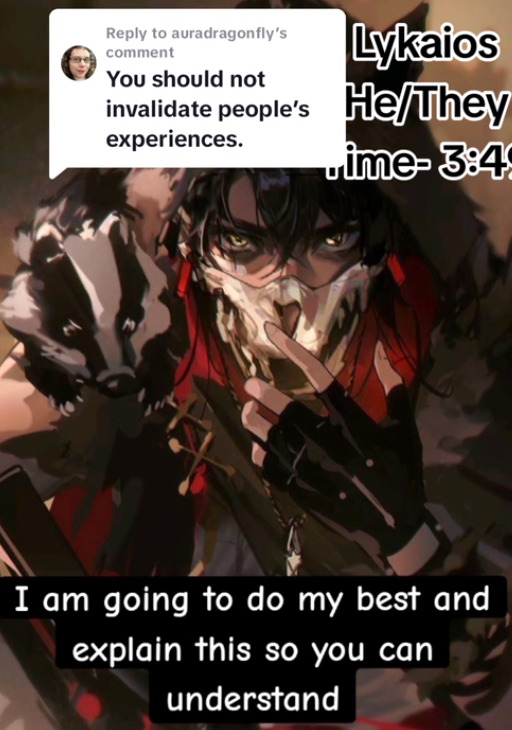
Thank you for that! Although I'm confused why you think explaining this so we can understand involves a robot reading in a whispery demonic murder voice.


How are you defining a "system?"
If this is going to be a semantic argument about how endos aren't technically systems because "system" is a DID/OSDD word then I'll point out that endogenic systems have called themselves systems since the 90s. And Internal Family Systems therapy has been around since the 80s, referring to people having multiple autonomous parts of their personality. The word has always been pretty open, even in this context.


If you read closely within the DSM-5, you will find exemptions for spiritual plurality in the form of possession states.
I believe this exemption can be found in "carteria" D.
And remember that the DSM-5 isn't the only diagnostic handbook in the world and the ICD-11 states that you can experience multiple "distinct personality states" without a disorder. This is the same wording the ICD-11 uses to refer to alters.
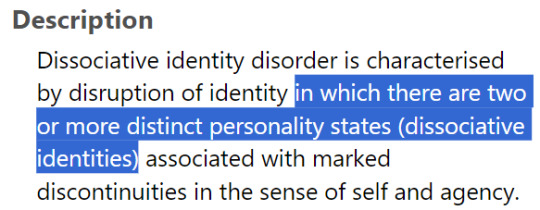
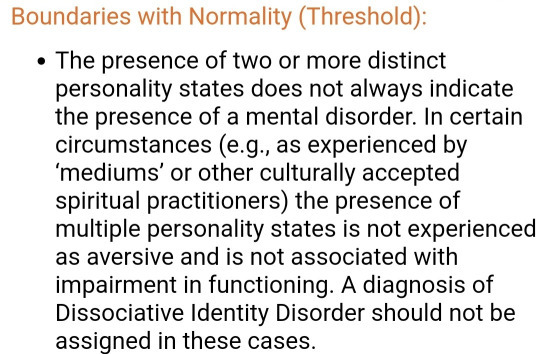

And endogenic plurality was originally referred to as "natural multiplicity" which has existed since the 90s.
Additionally, Kluft speculated in 2001 that there could be a nonpathological endogenous forms of dissociative identity disorder.



Wait... commit what?
A felony?
Commit to marriage?
Just... commit in general? Don't leave me hanging!
Oh wait, you were going to throw out the S-word, right? "Don't say endogenic systems exist or some DID system might unalive themselves." 🙄
This is fearmongering BS and emotional manipulation.
DID systems aren't going to be "harass" because people acknowledge endogenic systems exist. These things have nothing to do with the other. People were fakeclaimed and harassed for being systems long before the internet was a thing, and there's no indication the presence of endogenic systems has contributed to this in any way.


Come on! I already showed you the ICD-11 and the quote from Kluft. I swear, it's like you're not even reading what I wrote. 😔
But sure. How about Eric Yarbrough, Distinguished Fellow of the American Psychiatric Association, in a book reviewed and published by the APA themselves?
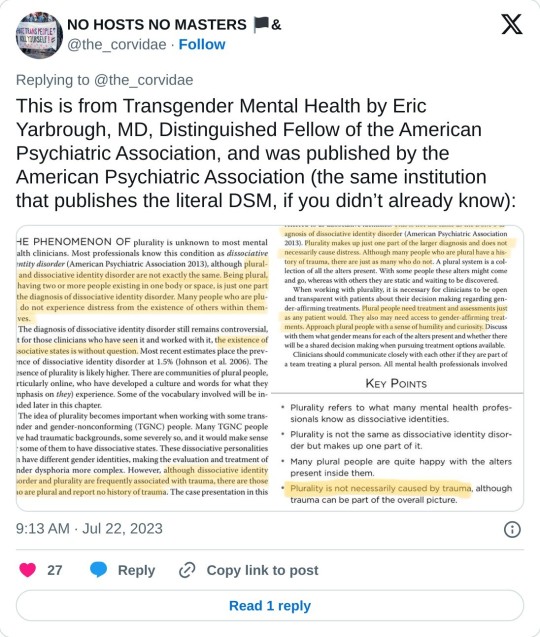
Is that enough for you?
I could go on, but you did only ask for one. 🤷♀️
Actually, you know, as a bonus, I will just link to Varieties of tulpa Experiences. Written by a psychiatry professor at McGill University, and published by the highly-reputable Oxford University Press.

Repeatedly asserting something doesn't make it true.

This appears to be vaguely referencing the theory of structural dissociation.
Assuming it is, I'll point out that even the creators of this theory have stated that it may be possible for someone to have multiple self-conscious dissociated parts of the personality from things other than trauma. Such as in hypnosis and mediumship.



No. No it's not.
Didn't you imply that you had read the DSM-5 earlier? Because while trauma is highly associated with DID, trauma certainly isn't in the "carteria." Nor is it in the criteria either.
And while it does mention that studies have shown that upwards of 90% of DID cases are linked with trauma, there are no such statements made for studies into OSDD.
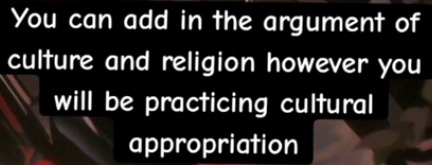

Please, tell me what culture is supposedly being appropriated by just believing in the very concept of mediumship and possession?
This is something that exists in nearly every single culture on the planet in some form or another. (Some positive, some negative.) Nobody owns it. And you can't just say literally all spiritual systems are appropriating a culture by virtue of being spiritual.
By that logic, you may as well say reality shifters are appropriating every culture that believed dreams would take you to other worlds.
#syscourse#sysblr#multiplicity#psychiatry#tiktok#systok#debunking#psychology#systems#actually a system#actually plural
21 notes
·
View notes
Note
What do you think about Alys’ magic abilities? Since she was follower of Old Gods, do you think she was greenseer or skinchanger?
I do think that Larys is indeed a skinchanger, who enters mind of rats, so he’s able to spy over Red Keep. And in leaked audition tape Alys was joking(or not) she is barn owl who was cursed to live in human body, can it be a hint she’s able to skin change into animals too?
It said that only one in thousand is born a skinchanger and only one skinchanger in a thousand is born a greenseer. And greenseers known for having greensight, so I don’t think Larys is one of them, but Alys is described to have visions in multiple sources, some kind of greensight.
And with Ewan hinting that Aemond will know day he dies, Alys potentially can be the one who predicts it:
"That was one of the first things [showrunners] Ryan Condal and Miguel Sapochnik wanted to think about: the legend of The Cyclops in Greek mythology, and how he ultimately traded one of his eyes to Hades in order to see the day he would die,"
"What does that do to a person, to possess that extreme degree of self-certainty? To know the day you're going to go down, and feel bulletproof to a point. I'm not saying Aemond is a seer, but he's scary perceptive."
And it’s interesting if she’s indeed a greenseer, unlike Bran and Bloodraven, who both were men in power, she was just a serving bastard.
What’s your personal assumption about this?
Hello nonnie, I hope you're doing well.
I sound like a broken record now -- but once again, I apologize for the delayed response. I'm so glad you found the time to ask this question because it prompted me to go back and read all the articles I had previously overlooked.
NOW... Ewan and Ryan both hinting at Aemond being privy to his own impending death is HUGEEE! If Aemond is somehow made aware of it through Alys' visions, then that completely removes the likelihood of her orchestrating his death. If makers don't botch the narrative they've employed for his storyline till now, then Aemond's character is primed to be one of the most tragic characters in HoTD. There is very good possibility that by the end of his journey, he feels like an absolute failure who's doomed his own cause to a potential defeat. In that scenario, when all hope is lost, I can totally see his character gambling everything away for that one final triumph that will not only assure the removal of the biggest possible threat -- but also offer him the retribution for B&C. Incidentally, there is also a high likelihood that we are reading too much into these quotes which were intended as some casual, off-handed remarks on Aemond's character study... I don't know.
Moving right along, me and some of my fellow shippers have been knee-deep in some fascinating headcanons recently. We’ve all largely agreed that both Alys and Larys could be skinchangers. I am not sure if Alys will be explored beyond her role in the Dance, but the theory of her being a 'greenseer' is an interesting one. I have read so many theories on Alys - from those guessing at a connection with Asshai and Quaithe to those believing her magic is derived from necromancy or blood magic. These are all interesting theories for sure, and opens a wonderful opportunity to explore more AUs.
I am excited to see what the makers have in store for us. She's such an interesting character, with both teams vying for her fealty on these online spaces. Our girl's definitely got many intrigued -- and I have even seen some TG fans suggest that the relationship between Aemond and Alys could be strictly platonic in the show. If that is the case, her story will either conclude at the battle above God's Eye or - in rare one-off case - they might even kill her character in the middle of a war. The makers are certainly not hesitant to change character arcs in the show, so nothing's off the table.
Thanks once again for this lovely ask!
Love, Kalki 🤗
#anon asks#alysmond hive#coven convening#hotd discourse#hotd speculation#aemond targaryen#alys rivers#alysmond#alys x aemond
33 notes
·
View notes
Note
What would have lead to Hyrule being MORE then 10,000 years old in your timeline? Most states and cultures IRL don’t even last above several centuries at most, so I wonder what’s the reason for it’s epithet as the “Eternal Kingdom” as mentioned in one of your posts
So... the name "Eternal Kingdom" is mainly what other countries outside of the Hyrule's border called them. Since from their perspective, the Kingdom of Hyrule had a very long and unbroken rule over its lands for 10 000 years under the same name and same ruling royal family. With evidences that they do have some level of divinity to back them up.
As opposed to themselves who may have gone through cycles of change. For example, my version of Ordon - their own recorded history goes back at least 9000 years with multiple eras of different rulers, governance, disasters and significant events that shape them into their present-day state. These countries and their people don't essentially need to know Hyrule's origins and take it into account with how they view this ancient Kingdom. But as far as they are aware, Hyrule has always been there. Until the day of the Second Calamity and how that shattered Hyrule's 10K year long streak.
.
As for how old Hyrule actually is, I put an asterisk on the " 10 000 years* " since it's a bit vague and they didn't really give definite dates on when exactly certain events occurred and how far apart they happened from each other.
My interpretation of the BotW-TotK timeline is that the Founding of the Kingdom of Hyrule, the Imprisoning Wars and later the First Calamity happened WITHIN the Ancient Era of 10K. And the Age of Zonai along with precedessors of the Ancient Hyruleans existed for some time before the Kingdom's founding. (The exact number of years / dates lost or forgotten from historical records ).
At least from the standpoint of BotW/TotK's present-day. Since it happened so far back in time that its all mashed together into a blur.
Its implied that very little of recorded history from back then survived to present-day. Either because of written text being lost or destroyed, language drift (similar to how Ancient Egyptian hieroglyphs were misinterpreted/untranslatable for the longest time until the Rosetta Stone discovery in 1799) or they were forgotten from living memory. Or even a combination of all above.
TL;DR - the Kingdom of Hyrule is estimated to be 10 000-ish years old in the BotW-TotK timeline, based on in-game lore and history. And because of their extreme longevity, the Kingdom is sometimes called the "Eternal Kingdom" by their neighbours.
--
Lastly, this is a rule I give to myself when it comes to worldbuilding, whether it be with the Legend of Zelda or...any fictional world I play around with.
The fictional world and their lore does not essentially have to be realistic, to our real world standards. It only needs to be believable within the rules of their fantastical universe.
(Quoted by me cuz I made that up, 05 Sept 2023)
What I mean by this is that, it is okay to take inspiration from real world history, culture and people when building up your stories and the world that it is set in. How realistic you want your worlds and stories to be is completely up to you. BUT it is not essential. You can be as fantastical and mind-blowing as you want in your world and stories. As long as it is believable to the reader / player.
Hyrule being 10 000(ish) years old is frankly mind-bending and almost eldritch to think about. And that's okay. You can accept that official canon or not. And let's be honest, Nintendo is not that well-known for their lore building in their games. And the canon Zelda timeline is already a mess to follow with.
(Also do check out Overly Sarcastic Productuon's video about BotW-Hyrule and its environmental storytelling (pre-TotK release). It has influenced how I interpret this specific version of Hyrule).
Personally, realism for me is more of a source of inspiration rather than a hard rule to how my worlds work. I build my worlds to be...places that I want to explore. With that feeling of exploration to immerse people into what this world is like and their in-universe lore adds layers that can excite the imagination.
And that's the beauty of worldbuilding. You can make the most fantastical world with magic, dragons and aliens, or the most realistic world based on real life but with mechas, dinosaurs and cowboys. Because why not!
The only limitation is your own imagination and how you build it up.
TL;DR - You can worldbuild the most realistic or fantastical world as much as you want. As long as it is believable to the reader that they too can imagine your world in their own imaginations.
#answered#worldbuilding#zelda worldbuilding#zelda lore#project ordon#botw project ordon#botw totk project ordon#botw totk beyond hyrule#botw beyond hyrule#legend of zelda#breath of the wild#botw#tears of the kingdom#totk
40 notes
·
View notes
Text

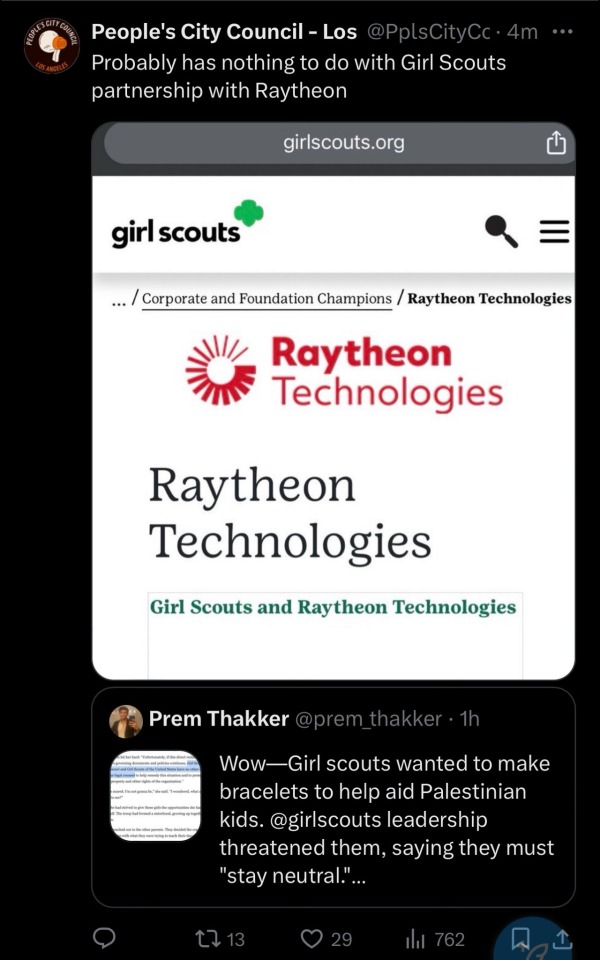






News. Didn’t sleep much last night so I’ll have to do captions and more detailed stuff later, my sincere apologies.
Here’s a sumup for Feb 22, 2024:
Norway has divested $500 million from Israel bonds. A huge win for BDS movements. More info and the original tweet thread can be found here.
Hundreds of protestors begin again in the Bay Area, directly to Biden’s fund raiser in SF. All of the standalone images are from this event, as reported by Kqed, found via Instagram here. Descriptions for images are attached to each. Entire post contents are as follows: “kqednews Protesters demanding a cease-fire in Gaza gathered Wednesday night near a fundraiser in San Francisco for President Joe Biden's 2024 campaign. Hundreds of activists filled Alta Plaza Park as part of the demonstration organized by the Palestinian Youth Movement and the Party for Socialism and Liberation. Protestors chanted "free, free Palestine" and "from the river to the sea, Palestine will be free" and urged the president to end U.S. aid to Israel. "How dare he visit San Francisco only to rake in cash, ignoring residents of a city which passed a ceasefire resolution with a supermajority?", said Suzanne Ali, a Palestinian Youth Movement member, in a written statement. "While Biden charges donors $100,000 for a ticket to his cocktail party, bombs labeled 'Made in the USA' are raining down on civilians in Gaza for the fourth consecutive month, killing over 13,000 Palestinian children and counting." "We are demanding that there is a permanent ceasefire now," said Party for Socialism and Liberation member Ramsey Robinson, who spoke at the protest. "That's our money, stolen from the people, stolen from the taxpayers, and we want to let Joe Biden know that we know that." President Biden is reportedly making multiple campaign stops in San Francisco and Los Altos Hills between Wednesday and Thursday. But Robinson thinks that other than "the tiny number of the super rich," Biden isn't popular in the Bay Area. Read for more details at kqed.org/news”
Girl Scouts have received funding from Raytheon Tech and has made “stay neutral” merch. We hates a neutral ass bitch, sorry Girl Scouts, not sorry. Full story, from @prem_thakker : “Wow—Girl scouts wanted to make bracelets to help aid Palestinian kids. @girlscouts leadership threatened them, saying they must "stay neutral." After it was pointed out there've been similar efforts for Ukraine, they pivoted, saying the troop didn't follow "approval processes:” Prem then displays another image which says: “The last sentence hit her hard: "Unfortunately, if this direct violation of the organization's governing documents and policies continues, Girl Scouts of Eastern Missouri and Girl Scouts of the United States have no other choice than to engage our legal counsel to help remedy this situation and to protect the intellectual property and other rights of the organization." "I got a little scared; I'm not gonna lie," she said. "I wondered, what are they going to do to me?* For years, she had strived to give these girls the opportunities she had missed out on herself. The troop had formed a sisterhood, growing up together since kindergarten. Abuhamdeh reached out to the other parents. They decided the organization's values didn't align with what they were trying to teach their daughters.” I’m unclear where this image/quote was taken from, presumably from the original reporting of STLtoday.com
There’s additional tweets from Prem, which talk more about Girlscouts & weapons contractors here. The images at source are screencaps (from the girlscout website) which I’ll share here:

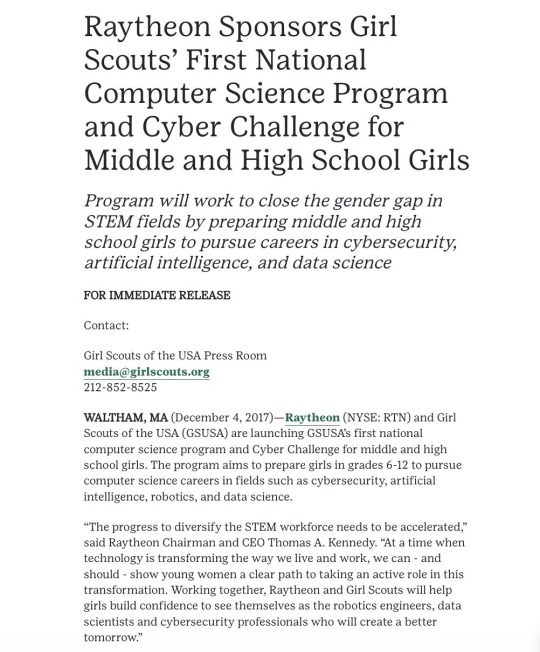
The last two images are the most important; the first depicts an image of a Palestinian boy holding a blanket he has apparently salvaged from rubble. The tweet from @Times of Gaza reports at 2:50 am of Feb 22, “Day 139 | During the past 24 hours: 9 massacres committed by the Israeli occupation • 97 people killed • 132 injured.” At 10:52 am @Times of Gaza reports: “UPDATE | 23 people killed in the Deir Al-Balah airstrikes. The death toll is expected to rise.”
This continued loss of life is irreplaceable and my heart mourns for them. FREE PALESTINE please God.
Eta: I added text to all images for my comrades who need it. I also added a couple new images for Girl Scouts info (I had to remove a redundant img of the Kqed insta, in order to include this info). Please LMK in the notes if it’s more helpful/ easier for yall for img notes or directly in my post. My brain is fried, I’m sorry this is such a haphazard post.
Biden and Raytheon info will have to wait til tomorrow. I also hope to get some info/ articles up about Israel and diamond trade - responsible for a huge portion of Israel’s GDP and stolen exploited resources from the Congo.
#free palestine#palestine#gaza#news#current events#bds#boycott#divest#sanction#fuck Israel#israel lies#israel crimes#israel is a terrorist state#stop Israel#palestine lives matter#from the river to the sea palestine will be free#San Francisco#Bay Area#joe biden#Biden Raytheon#Raytheon technologies#free congo#congo genocide#save Congo
17 notes
·
View notes
Note
i think you're qefinitely just wrong anq being "in a different universe" has nothing to do with it, put now i want to know which barts you think aren't real.

=> I will be answering this on Mod Remele's behalf since I don't feel it would be particularly beneficial for her to deal with further provoking on this matter => However, I think it's quite clear that she would have been referring to this quote; "[...] as cusps, brights, dulls, pigment shifts, and other color related mutations result in a rejection from most lusii," (Eel, Beforus-Cringe-Collector, '23)
=> 'Cusps' are extraordinarily well known to be a fictional type of troll invented for the popular book series In Which A Seadweller Is Born Also A Highblood And Unites The Two Castes In An Ultimate Form Of Water Based Clownery Etc (4675 AE) => In the sweeps since this book was released, the rare and fictional spliced troll caste appearance (commonly referred to as 'Cusps') has grown in popularity online => However, it has never been recorded in any living troll and is consequently not based in any reality => The idea of using this term in an academic context is honestly quite laughable
=> "Brights" and "Dulls", in a similar manner, are words that to my knowledge find their source in the theory first published by docterrorist Anrwir Belshr (5200), who proposed that there may be variations in the set blood colors of the existing caste system => Particularly 'Saturation Shifts', which in his hypothesis were unique to most trolls and could be drawn in scale => However this was later proved unfounded by Arioch Temter in a responsive study (5220) => Who was able to demonstrate through multiple test subjects that variations in 'Saturation' across trolls of the same caste was only found in anecdotal evidence => These were discovered to be caused by oxygenation levels, and occasionally dissimilarities in the individuals' diet, fitness, and overall health => The idea that blood within the same caste of individuals can be different is really nothing more than pseudoscience at this point => And continuing to spread this kind of information as fact or without at least warning of its existence as anecdotal is misleading and quite inappropriate for a scientist
=> "Pigment Shifts" is a term that can refer to multiple different conditions => Some of which (e.g. the "Iridescent blood" had by magic users in popular fantasy television show In Which Occultist Ritual Holders Attempt To Summon Spirits Without Psionics Etc (5525)) is purely fictional => Others (such as non-caste blood colors) are real and have been recorded for millennia, though it is inappropriate to speak about in detail => They are more commonly referred to simply as blood-color mutations
=> Grouping all of these terms together is something I would consider unfounded and even astounding in academics => Rather it is something you see by young fandom enthusiasts on online forums much like Grumblr => It was entirely appropriate for Mod Remele to regard these statements with suspicion => As more than half of them were completely non-scientific in nature
=> Really, she was actually being quite generous to assume the troll in question was from an "Alternate Dimension" => Due to the extremely unprofessional taunting she's received since responding to that, I think it's much more likely that these trolls do not take their science seriously whatsoever => Which is a shame => But not our fucking problem
#=> Do not attempt to mock young miss Remele again#=> I will not be quite as nice next time#=> Mod Galekh
22 notes
·
View notes